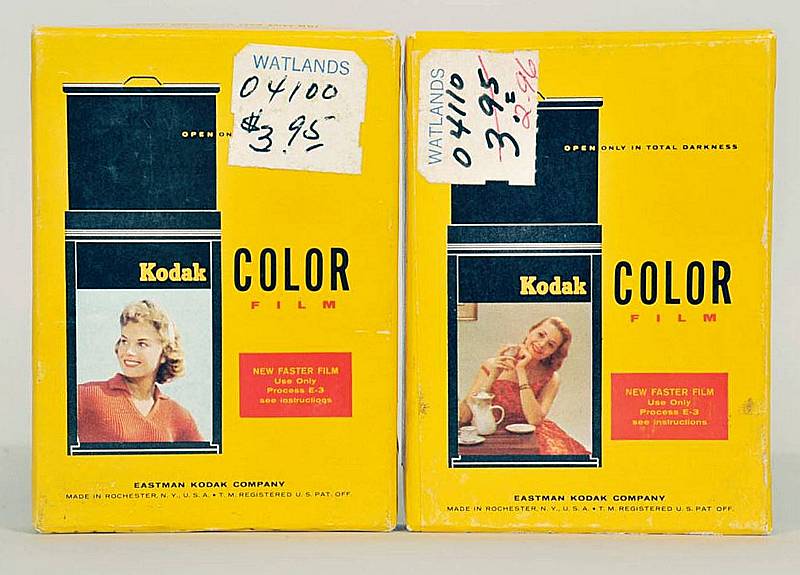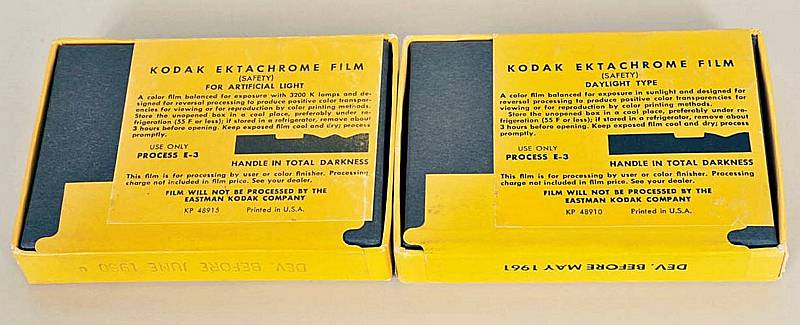| Kodak Ektachrome Colour Transparency films - researched by Michael Talbert |
|
Kodacolor Aero Reversible Film In 1939, Vittum and Jelly, of Eastman Kodak, discovered a type of colour coupler which, unlike the Kodachrome developer couplers, could be combined with the three emulsion layers of a colour film. The new couplers were incorporated into a resinous binder. They were known as “Protected Couplers”, as they were carried in small particles of organic materials which protected them from any reactions of the silver bromide emulsions. The colour couplers were then within the emulsion but not in complete physical contact with it. Like Agfa’s Agfacolor Neu film of 1936, any colour material, film or paper, having the colour couplers combined with the three emulsion layers at the time of manufacture, could be processed in a much simpler, and much faster, manner than that of Kodachrome. Only one colour developer and one bleach bath were required. The first film manufactured
by Eastman Kodak containing “Protected Couplers” was
Kodacolor Aero Reversible Film in 1940. The processing sequence and chemical baths for Kodacolor Aero Reversible film were not unlike the processing procedure and baths for the earliest type of Kodak Ektachrome sheet films. Kits of chemicals for making up the five processing baths were available. The procedure was much like Process E1 but with longer times, very likely at 68°F (20°C). The time taken to process the film, not including drying, was around 90 minutes. It was probably about 6 to 10 ASA and had a high contrast. Two sets of filters were supplied with the film, one filter to correct for the various emulsion differences, and to balance it for average daylight. The other filter, or filters, were to correct for “haze”, or blueishness in distant subjects. The “Haze” filters were likely to have been, “Wratten Filter No.1”, and “Wratten Filter No.2A”, 2A being slightly stronger. It was replaced, or renamed, ”Ektachrome Aero film – High contrast”, possibly in 1946. |
|
The chronology of the Kodak Ektachrome processing chemistry, E1 through to E6, can be learned by reading the Sections below. Because the colour couplers were included in the emulsions (unlike Kodachrome), Ektachrome film could be processed using a much simpler procedure than Kodachrome, involving only one colour developer. Essentially, the E1 Process,
though not known by that title at the outset, was available from
1946 in the US and 1947 in the UK. The E2 Process appeared around 1955 for Kodak's 32ASA (ISO) film. Process E3 arrived in 1959 with a 50ASA film. Then a jump was made to a 160ASA Ektachrome (also known as High Speed Ektachrome) later that year. 1966 saw the introduction of Process E4 for Ektachrome X and High Speed Ektachrome. Processes E3 and E4 were used during the same years and some films were occasionally mixed up by users, so Kodak tried for a single new improved process with accompanying new films. Process E5 proved to be a development hiccup. Process E6 appeared from 1976
and three new E6 Ektachrome films accompanied this introduction,
namely Ektachrome 64, Ektachrome 200 (ISO; Daylight balanced)
and Ektachrome 160 (ISO; Tungsten balanced). |
|
Ektachrome film was first introduced in sheet film format in 1946. Based on the earlier Kodacolor aero film, Ektachrome had a much lower contrast and was obtainable in a Daylight balanced film and an Artificial light balanced film. The artificial light type film was known as 'Type B', balanced for 3200°K lamps (see picture, below). The Daylight film had a speed of 8ASA (ISO), and the Type B film was rated at 10ASA (ISO). Both versions were designed for processing by the photographer in the “Ektachrome Processing Kit”. There are reports of Ektachrome film being processed in “Kodacolor Aero Reversible film” chemical kits, but the first developer had to be substituted for another type. One report states that the Kodacolor Aero kit gave “bright, contrasty transparencies with slight blueness in the shadows” on Ektachrome film. About a year later, a daylight type roll film was put on the market. The emulsion was exactly the same as the daylight sheet film. It was supplied in 620 and 120 sizes and the data sheet warns “It cannot be used satisfactorily in box or other simple cameras”. It’s speed to daylight exposures was 8 ASA, but Michael Talbert has seen where some sources mention a speed of 6ASA. It has also been reported that Kodak reduced the speed by one third of a stop for the daylight film in 1948 due to a re-assessment of the film’s capabilities. The actual film was not changed and no evidence can be found of this appearing in the official Eastman Kodak data sheets for the daylight type film. Both films were “code notched” for identification in the dark. It was not possible to use a safelight; both films had to be handled in total darkness. The daylight film had one notch cut into the edge of the film and the Type B film had two notches. It was possible to expose the Type B film to daylight using a Kodak Wratten filter No. 85B on the lens. The speed of the film then dropped to 6ASA. Flash exposures, with clear flashbulbs, were made with a Kodak Wratten filter No. CC95 and the instruction sheet gives tables listing various guide numbers for average and large reflectors when using clear flashbulbs. From 1946, both types of sheet film were packed in boxes of 12 sheets. This quantity may have been changed to 10 sheets per box as from the early 1950s. Included in the earlier boxes of 12 sheets were 12 “Kodapak” transparency sleeves. When each sheet of Ektachrome film had been processed and dried, the finished transparency was inserted into a “Kodapak” sleeve for ease of handling to prevent fingerprints while also protecting the transparency from scratches. Below is shown an Ektachrome 4 x 5 inch sheet film box, dating from 1948. This film was balanced for Daylight. The “Develop Before” date is July 1949, meaning that the film was likely manufactured around September 1948. Some information has been taken from a 1948 Data sheet for the film. The Daylight Type film had a speed of 8 ASA (ISO). Best colour rendering was obtained by exposing in bright or hazy sunlight. Blue casts would result in exposing on an overcast day, or under a clear blue sky, or photographing distant views. To correct the blue cast Kodak recommended placing yellow filters over the lens such as CC13, CC14, CC15. The CC13 was the weakest but CC15 would correct a fairly strong blue cast. The film could be exposed to
other light sources such as: |
|
Prices
of Ektachrome Sheet Film in the UK in 1950~1952 The 3¼ x 2¼ inch is for sale at £1.16s.5d (£1.82p) per box. The quarter plate 4¼ x 3¼ inch is for sale at £2.10s.11d (£2.54p) per box. These prices did not include the cost of processing the film. It is very likely that this is “in date” film. However, the George Childe
prices for the Ektachrome sheet film boxes may have been either
trade prices or the price without Purchase Tax. This possibility
exists because, in the “Kodak Price Supplement” to
a Kodak catalogue for May 1952, a box of 2½ x 3½ inch
size Ektachrome film cost £1 15s 0d (£1.75)
for 10 sheets. The quarter plate size film, of the same
quantity was £2 10s 0d (£2.50). The “Kodak Price Supplement” for May 1952 lists both the Daylight and the Type B film for sale in sizes from 2¼ x 3¼ inches to 8 x 10 inches in boxes of 10 sheets. The film listed for sale may have been manufactured by Kodak at their factory at Wealdstone, Harrow, although the advertisements for Ektachrome film in the British Journal Photographic Almanacs for the early 1950s give the impression that only the Type B film was being made at Harrow, and the Daylight type film was not available. The title printed in the price list: “Ektachrome Type B sheet film and Ektachrome Daylight Type sheet film (Not available for export)” further suggests that the film was being manufactured in the UK. Processing Service Kodak would accept film sizes from 2¼ x 3¼ inches to half plate 6½ x 8½ inches for processing. For some reason, 8 x 10 inch film was not processed by Kodak, but at that time other trade laboratories were beginning to set up 3 gallon tank lines of the five solutions required to process Ektachrome film. John Piercy, Ltd, 34A Bryanston Street, London (near Marble Arch), was one of the first colour processing laboratories in the country to offer a processing service for Ektachrome, although I believe they first were established in Leicester Square, London as long ago as 1948. The Kodak processing service operated on a basis whereby the more sheets of film sent in for processing at one time, the lower was the price charged to process each individual sheet. Examples of processing charges, May 1952.
The prices are per sheet of film processed and were free of Purchase Tax. In 1950, a box of black and
white sheet film, such as Kodak Super XX, size 4¼ x 3¼ inches,
would have cost about 14 shillings (70p) for a 24 sheet
box. In the same advertisement are “Ektachrome Processing Outfits” for sale at £1 10s 0d each (£1.50 ) but it does not say what size of outfit or how many films can be processed in each outfit. Kodachrome Professional sheet film was withdrawn from sale in May 1951 and was no longer manufactured. The processing service for this film was discontinued on 31st July 1952. |
|||||||||||||||||||||||||||||||||||||||||||||||||
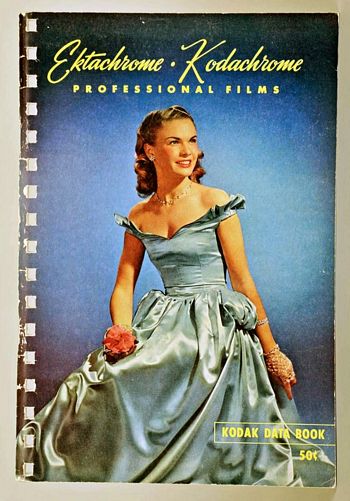 |
|
||||||||||||||||||||||||||||||||||||||||||||||||
|
Ektachrome
Exposure The instruction sheet and data sheet for the 'Type B' film included an exposure table for exposures to 3200°K lamps with subject to lamp distances ranging from 5feet to 20feet (6.1m). It is interesting to note that neither the instruction sheet nor the data sheet for the earliest made Ektachrome Type B film included any reference to increasing the exposure over a certain exposure time length due to Reciprocity Failure effects. The book “Ektachrome/Kodachrome Professional Films” states in the chapter “Exposure of Color films”, that the photographer must make his own tests using his own lighting set-up for exposure onto Type B film. For critical work film the same emulsion number was used to make the trial exposures and the final exposures. Eastman Kodak stated that the manufacturing variations between successive batches of film were small, with colour differences easily corrected within the range of Kodak CC23, CC33, and CC43 filters. The CC range of Kodak Colour Compensating filters marked in subtractive colours did not exist in the mid-1940s. The equivalent to CC23, CC33, and CC43 was likely to be the 10 densities of Yellow, Magenta and Cyan. (CC10Y, CC10M,CC10C) The speed of the film was unlikely to vary much more than half a stop at the time of manufacture. As far as Michael is aware, the standard exposure for the earliest Ektachrome film was about 1 second, and production tests by Eastman Kodak may have been made at this exposure. It is likely that exposures longer than 5 seconds may have had to be increased somewhat because of Reciprocity Failure effects. This increase would have varied slightly from one batch of film to another. By the late-1940s, a supplementary instruction sheet was being packed into Ektachrome Type B film boxes giving exposure and filter recommendations for times of 10 seconds and 120 seconds. An idea of the exposure increases are given by a later table dating from the early-1950s. An exposure of 10 seconds required an exposure increase of about 1 stop, (i.e. equivalent tp an exposure increase to 20 seconds), and 120 seconds required an increase of around four times the 120 second exposure (i.e. equivalent to an exposure increase to 8 minutes !). At longer exposure times the colour balance would change necessitating the use of Colour Compensating filters to correct the balance. Ektachrome
Processing From 1946, all Ektachrome film was made by the Eastman Kodak Company at Rochester, N.Y., U.S.A. As far as Michael Talbert understands, the film was first marketed in the U.K. in 1947. As the film was intended to be processed by the user, kits of chemicals were available in 2 litre and 5 litre sizes. In the U.K., in 1947 to 1948, only small amounts of Ektachrome sheet film and the necessary processing kits were imported into the U.K., mainly for bonefide professional photographers. Owing to import restrictions at that time, and to make the most of the processing chemicals that could be imported, Kodak in the U.K. set up a processing service for Ektachrome film at Harrow. By 1948, only the Type B film was available (see Early Ektachrome Film, above). Michael believes (ref: the British Journal Photographic Almanacs) that Kodachrome sheet film was not actually sold in the UK after the war. Although the BJ Almanac for 1947 mentions “Kodachrome Professional Film” in the Kodak advertisement (referring to sheet film Kodachrome), this "Kodachrome Professional Film" had been replaced by “Ektachrome Film” in the Kodak advert in the 1948 BJ Almanac. By 1950 Ektachrome film had replaced Kodachome in sheet film format and by 1951 Kodachrome sheet film production had ceased altogether. Eastman Kodak presumably wanted to sell an alternative to Kodachrome sheet film and hence made Ektachrome available. The main reason for Kodak deferring from Kodachrome is likely to be that Kodachrome in sheet film format would have been difficult and expensive for them to process. 35mm film is quite the opposite, since multiple films can be spliced together in the same way as Motion Picture film, and passed through machines as one continuous band of film. But you can’t splice together sheet film, and also it comes in different sizes. No wonder they stopped making it altogether in 1951!. |
|||||||||||||||||||||||||||||||||||||||||||||||||
|
1946
Processing sequence Lower down are two pages of processing instructions, which date to October 1946. These instruction sheets have the number KP31336 with an A suffix, suggesting they are a first reprint. |
|||||||||||||||||||||||||||||||||||||||||||||||||
|
|
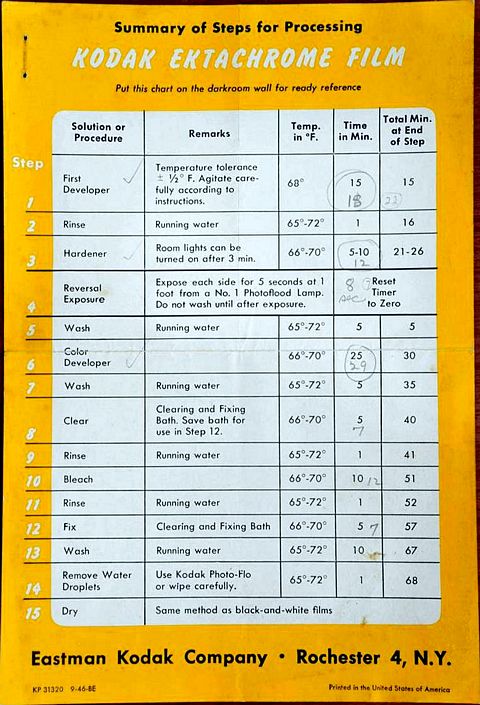 |
||||||||||||||||||||||||||||||||||||||||||||||||
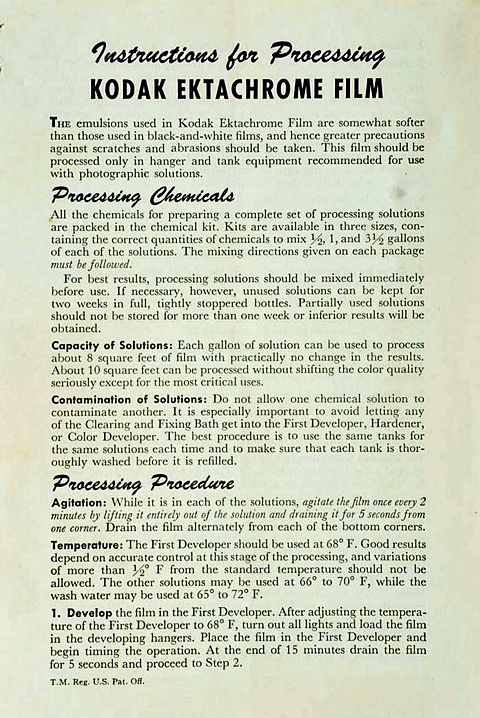 |
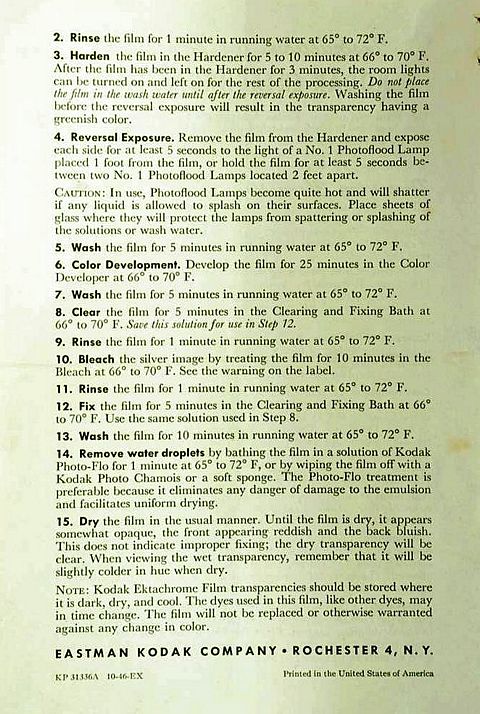 |
||||||||||||||||||||||||||||||||||||||||||||||||
|
Notes:-
By 1949 Ektachrome film was being made at Kodak’s Harrow plant in the U.K. Various formulae for the five processing solutions were suggested in the late 1940s to early 1950s, many of them published in the British Journal of Photography magazine and “BJ” Almanacs. Most formulae for the Colour Developer used May and Baker’s “Genochrome” for the colour developing agent. The quantity of this could be varied to alter the colour balance when making up the colour developer. In 1949, the process times were reduced by enabling the higher temperature of 75°F. The film was now hardened during manufacture, to withstand the higher processing temperature. As far as Michael knows, by 1952 the film was only manufactured by Eastman Kodak at Rochester, N.Y., and Ektachrome film was no longer made in the U.K. |
|||||||||||||||||||||||||||||||||||||||||||||||||
|
|
|||||||||||||||||||||||||||||||||||||||||||||||||
|
Below is a later sequence, dating from 1954, with the higher 75°F temperature timing. At this time, Ektachrome film was obtainable in Daylight and Type B sheet film, and Daylight type 120 and 620 roll film. Various sizes of processing kits were available. Post 1955, with the arrival of Process E2 films and chemistry (see next Section), this earlier chemistry became known as Process E1.
Notes:-
E1 sheet films and E1 processing
chemicals only were listed for sale in the February 1960 Kodak
Professional Catalogue for the UK. |
|||||||||||||||||||||||||||||||||||||||||||||||||
| Boxes of Ektachrome 'Process E-1' film, mid 1950s to 1960. | |||||||||||||||||||||||||||||||||||||||||||||||||

|
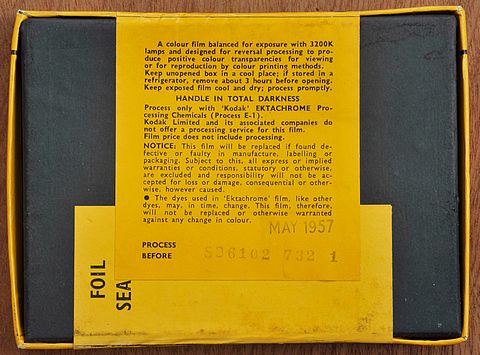
|
||||||||||||||||||||||||||||||||||||||||||||||||
 |
|||||||||||||||||||||||||||||||||||||||||||||||||
 |
|||||||||||||||||||||||||||||||||||||||||||||||||
|
Below are two further boxes
of Ektachrome film for Process E1. 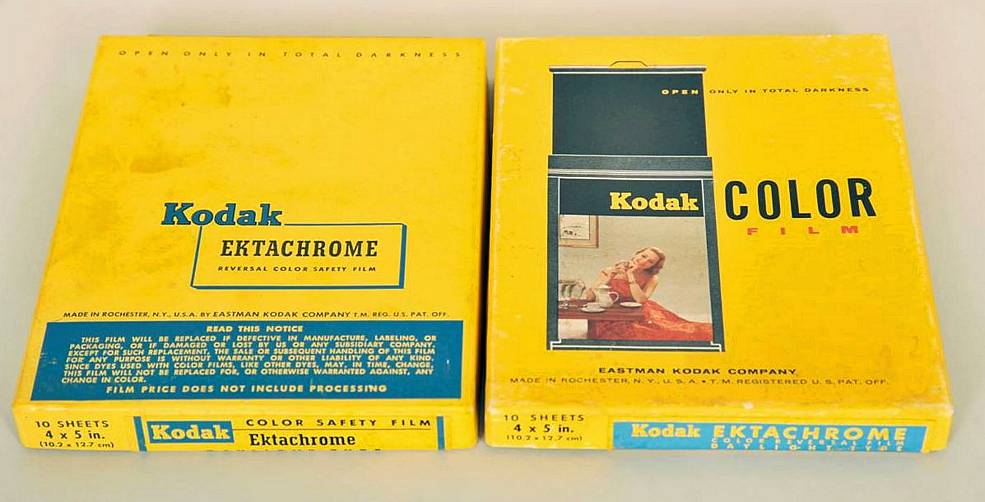 |
|||||||||||||||||||||||||||||||||||||||||||||||||
|
Rear label from Ektachrome E1 film box (left hand side, above) dated April 1959.  |
|||||||||||||||||||||||||||||||||||||||||||||||||
|
Box
of Ektachrome Process E-1 film ~ 6102
It was also suggested that, for critical use, the photographer made a trial exposure at an exposure time of one second to find out if any colour correction filter was necessary at this exposure time. If a filter was found necessary it would be combined with any other colour correction filter(s) when the film was exposed at longer exposure times. The supplementary data sheet for this particular batch of film, batch No. 6102 873 gives the emulsion speed as “Normal”, i.e. 10 ASA (ISO). The data sheet also gave information on colour balance correction for exposures at long and very long exposure times. For long exposure times of about 10seconds a CC05C filter, (5 unit Cyan filter) was suggested plus an exposure increase of half a stop. For very long exposure times of around 120seconds a CC10C filter, (10 unit Cyan filter) was suggested plus an exposure increase of 2 stops. From this information it can be concluded that the colour balance of the film turns red with longer exposures. Example
of how to use this film: The supplementary data sheet also suggested any exposure adjustment when using clear flash bulbs as the light source at 1/50th second. |
|||||||||||||||||||||||||||||||||||||||||||||||||
|
The sealing label on the back of the above box can be seen to the left. It is a bit odd, totally unlike the sealing label of the later E3 boxes, and may possibly have been made for a special purpose, or perhaps Eastman Kodak ran out of the normal labels and had to print some improvised labels for the very last batches of E1 film ! Above the expiry date of "Jan
1961" can be read "MIL. EXPIRY DATE". |
|||||||||||||||||||||||||||||||||||||||||||||||||
|
|
|||||||||||||||||||||||||||||||||||||||||||||||||||||||
|
In 1955, higher speed 32ASA (ISO) Ektachrome Daylight roll and 35mm films were put on the market, specifically designed for the amateur photographer. For the 35mm photographer it was a faster alternative to the well known Kodachrome Daylight film. Average exposure was 1/50th second at f11 in bright sunlight. The film was also suitable for exposure with blue flash bulbs and electronic flash. This type of lighting could also be used in daylight as “fill in” flash. The new Ektachrome film could also be exposed to Photoflood lighting with a Kodak Wratten filter No.80B, but this cut the film speed down to 12ASA (ISO). Film sizes available in the
U.S.A. in 1955 were: Ektachrome Daylight film was
first sold in the U.K. in 1956 when the same film sizes became
available as in the U.S.A., except that 828 film was not supplied.
At the same time, kits of chemicals for processing the film became
available in 600ccs, 2 litres, and 3 gallon sizes. These chemicals
were known collectively as “Process E2”. The
1954 process then became known as “Process E1”.
The Process E2 processing
sequence was almost
identical to the 1954 Process E1 procedure (see
above). But it used a different First Developer formula and
had other slight differences, viz: In 1959, the E2 films were
listed in the U.K. “Kodak Dealer’s Catalogue”
for that year as E120, E620, and E135 (20 exposures). Unlike all Kodachrome films, Ektachrome films were sold without the cost of the processing included in the price of the film. Chemical kits for the original E2 processing solutions were still listed in the 1959 “Kodak Dealer’s Catalogue”. A complete kit of size 600ccs for processing 8 films cost 17 shillings i.e. 17s (85p). A complete kit of size 2litres for processing 26 films cost £2.5shillings (£2.25p). Ektachrome
Process E2 ~ Type F Film It was also possible to make
exposures in other light sources such as: For the 35mm user, it gave a choice of an alternative film to Kodachrome Type F film, although Kodachrome Type F was two thirds of a stop slower. Sizes available in the U.S.A.
in 1955 were: The film is not listed in the U.K. Kodak catalogues for 1956 or 1959. The U.K. “Kodak Professional Catalogue” for 1961 lists the film in EF120 and EF135 (20 exposure cassettes). Manufacture of Ektachrome Daylight Type and Type F films were discontinued in 1962, being replaced by Ektachrome X film. |
|||||||||||||||||||||||||||||||||||||||||||||||||||||||
|
|
|||||||||||||||||||||||||||||||||||||||||||||||||||||||
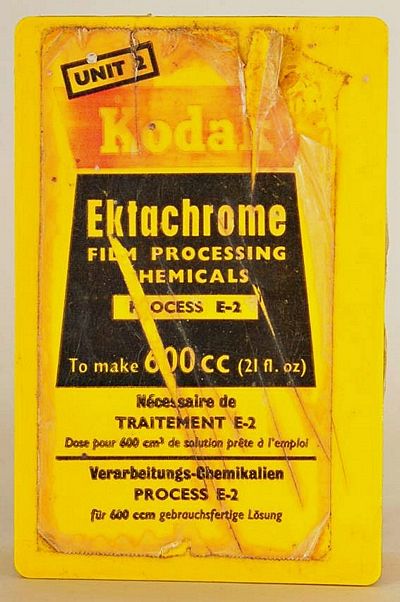 |
At the end of the 1950s, significant changes were made to the existing E2 roll and 35mm films, resulting in an 'Improved' Process E2 procedure with a modified First Developer and Bleach The Improved Process E2 chemistry was introduced in the U.K. from 1959 with 600ccs size kits, but this introduction occurred too late to be included in the “Kodak Dealer’s Catalogue” for that year. The separate chemical components were packed in two plastic boxes, one box, Unit 1, containing the two developers, and the other box, Unit 2 (see image, left), containing the Hardener, Clearing bath, Bleach, Fixer, and Stabilizer chemicals. With the “Improved Type” chemical solutions, the Clearing Bath and the Fixer were now separate solutions. A complete kit of “Improved Type“ E2 chemicals cost £1.2s.6d (£1.12p). The two Developers cost 12s (60p). The remaining chemicals cost 10s.6d (52p). All of these are late 1959 prices. The Unit 2 package shown alongside (left) is from an "Improved Type" processing kit, but dates to 1967, by which time Kodak had ceased to print “Improved Type” on the packaging. All Ektachrome E2 films could be processed in either the 'Original' or the Process E2 "Improved Type” kits, but the Improved Type chemistry gave a better colour rendering and clearer highlights. You could also put E2 films through E3 chemicals, as long as you then kept the two E3 developers specially for E2 films. At Art college Michael found it best to put several cut films through the process first to “ripen” the two colour developers, otherwise the freshly mixed chemistry resulted in a green cast on the film. Michael thinks it was 1968 or 1969 when Kodak finally stopped the manufacture of E2 chemicals. Process E2 ~ Unit 2 (see image). Michael Talbert purchased this Unit 2 part kit, along with the Unit 1 part, in January 1967, for his first attempt at processing colour film. All the enclosed chemicals were powders, except for the Stabilizer, and had to be mixed with water to make 600ccs working solution. The liquid Stabilizer was diluted with water to make 600ccs of working solution. The chemicals would (officially) keep for 8weeks, unused or partially used before needing replacement. This was a very conservative estimate and many users found that the chemicals would keep for at least another 4 weeks. Kodak enclosed a very informative 6 page instruction sheet with the Unit 1 part kit containing the First Developer and Colour Developer. |
||||||||||||||||||||||||||||||||||||||||||||||||||||||
| Process E2 'Improved Type' Procedure | |||||||||||||||||||||||||||||||||||||||||||||||||||||||
|
|||||||||||||||||||||||||||||||||||||||||||||||||||||||
|
Notes
The above process was also the sequence and timings for the later Ektachrome E3 process, described below. |
|||||||||||||||||||||||||||||||||||||||||||||||||||||||
| High Speed Ektachrome Film | |||||||||||||||||||||||||||||||||||||||||||||||||||||||

|
In 1959 an increased speed Ektachrome film was introduced, at first as 35mm film format in 20 exposure cassettes for exposure in Daylight. It’s speed was 160 ISO (ASA), over two stops faster than the regular Ektachrome film, (32 ASA). It was then the fastest colour film in the world. Next fastest was Super Anscochrome D, which was rated at 100 ISO (ASA) About a year later an artificial light type for 3200°K was made available as “High Speed Ektachrome Type B”, packed in 20 exposure 35mm cassettes, rated at 125 ISO (ASA). By 1963, 120 size roll films in both daylight and Type B films made their appearance.
Apart from processing High Speed Ektachrome using Process E2 into projectable colour slides (transparencies), it was possible to process High Speed Ektachrome as if it was a colour negative material, using the Kodacolor Process C-22. For examples, see below. |
||||||||||||||||||||||||||||||||||||||||||||||||||||||
.jpg) |
.jpg) |
Two colour negatives taken in 1971 on Kodak High Speed Ektachrome 120 roll film exposed at 250 ASA (ISO) and then processed as negatives. The film was processed in Kodacolor C-22 chemicals at 75°F using a colour development time of 7 minutes. The remainder of the process was exactly the same procedure as when processing Ektacolor or Kodacolor negative films. The result is an unmasked colour negative with a pronounced magenta cast. The purpose of using High Speed Ektachrome film as a negative material was to make use of a speed increase as the film could be rated at 250 ASA (ISO). High Speed Ektachrome film processed normally as a transparency in E2 or E4 chemicals was rated at 160 ASA (ISO). The fastest colour negative film obtainable in 1971 was Kodak Ektacolor Professional film Type S rated at 100 ASA (ISO). As well as a gain of about 1½ stops in speed there was also a gain in contrast as shown in these pictures taken in sunlight. There is also a slight colour “cross over” of red shadows and if the pictures were darker, cyan highlights would appear. This “cross over” would show more in a less contrasty subject. It would have been better to use this technique in very dull, flat lighting than sunlight. The colour “cross over” shows most in the “old barn” picture as red shadows with no detail, and the highlights, (the geese), are “burnt out”. The negatives shown here were scanned and the positive prints were made digitally but only the colour balance of the prints was corrected, the contrast was not altered. This is to show how the prints may have looked in 1971. When making the prints in 1971 from the unmasked negatives, a blank piece of Kodacolor film, i.e. an “orange” mask, was included with the printing filters to make the negatives more like masked colour negatives. The original 1971 prints were made on Kodak Ektacolor Commercial paper and the strong magenta cast, otherwise resulting in very green prints, was filtered to neutral using Yellow and Cyan printing filters.
|
.jpg) |
.jpg) |
|
E2 Formulae from the British Journal of Photography
Annual 1980 First Developer.
Hardener. This is a weak
Stop Bath.
Colour Developer
Clearing Bath. This is a
Stop Bath.
Bleach
Fixer
Stabilizer
|
|||||||||||||||||||||||||||||||||||||||||||||||||||||||||||||||||||||||||
|
|
||||||||||||||||
|
In 1959, new Process E3 Ektachrome films came onto the market, in sheet and roll film formats. The new sheet films were named:- The roll films were identical to the sheet film emulsions. The Daylight Type roll film was introduced at the same time as the Daylight Type sheet film, in 1959. The Type B E3 sheet film was produced perhaps a year earlier (1958), but the Type B rollfilm was introduced much later, in 1971. Both rollfilms were replaced by Process E6 emulsions in 1976. |
||||||||||||||||
|
Two very early Ektachrome Process E3 Film boxes Daylight Type (LHS) and Artificial Light Type B (RHS) Size 2¼ x 3¼ inches and labeled with instructions to “only use Process E3” chemicals. |
||||||||||||||||
|
Same boxes as above. The Daylight film was rated at 50 ASA (ISO). The Type B film was rated at 32 ASA (ISO) for a ½ second exposure, but the speed then dropped as low as 10 ASA (ISO) for a 30 second exposure. For exposures as long as 30 seconds, Kodak CC 05 Magenta plus Kodak CC 05 Red filters were recommended to be used in the supplementary instruction sheet. |
||||||||||||||||
|
Same boxes as above. As can be seen, the expiry dates were: May 1961 for the Daylight type film (RHS) and June 1960 for the Type B film. It is likely that Eastman Kodak were manufacturing Ektachrome sheet film for Process E3 and Process E1 concurrently for a year or so. Here the Type B film has an earlier expiry date than the Ektachrome Process E1 Type B sheet film box illustrated above (January 1961). |
||||||||||||||||
|
Process
E3 Procedure An instruction leaflet was included with the 2 gallon replenisher chemicals giving information in tabular form of amounts of replenisher to be added after each process for single or quantities of the various sizes of sheet film, roll film, and 35mm film for both E2 and E3 processes. The two gallon size replenisher chemicals were intended for use with three gallon tank installations and not for continuous processing machines. The E3 Process was replaced by the E6 process about 1977 (began replacement around 1976) and by then most laboratories had installed the necessary equipment to process the then new E6 films. But there must have been a short period of time during the changeover when a few laboratories were running an E3 Process, an E4 Process, and an E6 Process ! By 1978 the E3 and E4 films still on the market must have been out of date or very near their expiry date. The new sheet films and roll films designed for the Process E3 were processed in exactly the same way as the Process E2 improved Type films (above), using the same bath sequence but employing a First Developer incorporating a different developing agent. In consequence, films designated for the E2 process, (roll films and 35mm films), had to be processed separately from the new E3 sheet and roll films by using separate First Developers and Colour Developers. All other solutions were common to both processes. However, it was possible to process small amounts of E3 film through E2 developers provided the process was operating within tolerance. Control strips of pre-exposed film were processed at regular intervals to check that the process was operating within limits as regard to speed of films, contrast, and fog level. In the USA. and the UK, both E1 and E3 processing chemicals and kits were sold concurrently for a time. Gradually E1 film and chemicals were phased out, being replaced by the new E3 films and processing solutions. It is said (BJ Almanac 1961) that the new E3 films gave improved definition and considerably better colour rendering of yellows and greens; also cleaner whites. |
 Sufficient for 2 litres of solutions. |
|||||||||||||||
|
Ektachrome
E3 Daylight Type Sheet Film ~ 6115 The new Ektachrome sheet film was available in Daylight type, rated at 50 ISO (ASA), and also as an artificial light Type B version (3200°K), designed for exposure at times of ½second or longer with a nominal speed of 32 ISO (ASA). This sheet film was first available for sale in the USA in 1959, in formats from 2¼ x 3¼inches to 11 x 14inches, plus 5 sizes in square centimeters. The same emulsion was obtainable in rollfilm, EP 120 and EP 620. According to the BJ Almanac for 1960, E3 film was not available for sale in the UK in late 1959 and the same Almanac still gave information on the old E1 sheet film. A year later, E3 film was being sold in the UK and a 4 inch x 5 inch size box of 10 sheets of film cost £4 8s 2d in 1961. A box of equivalent size black and white film in 1961, say Plus X, cost about £1 4s (£1.20), but this was for 25 sheets of film. It should be remembered that the Chancellor, Selwyn Lloyd, announced a surcharge of 10% on Purchase Tax in July 1961, so the price of film would have risen during the latter part of the year. The Data Sheet for Ektachrome Daylight film, dated March 1959, states that the best colour rendering is obtained in clear or hazy sunlight, and gives filter suggestions for other light sources and guide numbers for blue flashbulbs and electronic flash. The speed of the film varied between 40 ISO (ASA) and 64 ISO (ASA). A supplementary data sheet, together with an instruction sheet of 4 pages packed with the film, stated the correct speed for each emulsion. Also printed on the supplementary data sheet was a filter suggestion for exposing the film with electronic flash tubes, usually a CC10Y filter = 10 Yellow. The emulsion number of the film was printed on the sheet and on the left side of the box. Also, it was embossed on each sheet of film. |
||||||||||||||||
.jpg)
|
.jpg) |
|||||||||||||||
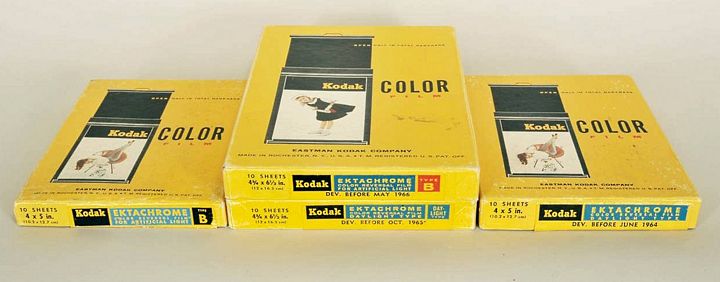 |
To the left are shown various E3 film boxes, containing both Daylight and Type B film. These boxes date from the early 1960s; the Type B film box on the left is dated “February 1963”, the film being manufactured about March 1962. The “Dev. Before” date was originally printed on the back end of the box. Its position was changed to the front end in about June 1964, as is the case with the middle two boxes, and the box to the right hand side. |
|||||||||||||||
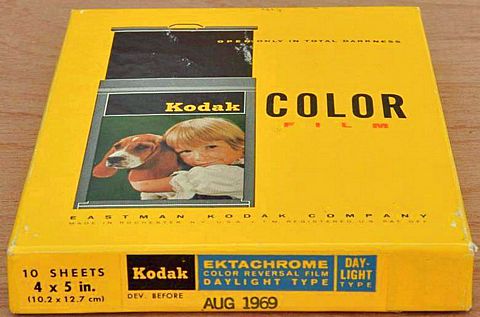 |
 The rear label of all Ektachrome sheet film manufactured in the USA from early 1969 show only the storage recommendations, printed in several languages. The colour sheet film boxes were also of a different design (see: Ektachrome sheet film, dated March 1971, below). |
|||||||||||||||
 |
Alongside are Kodak Ektachrome Process E3 film boxes from the late 1960s to the mid-1970s. The small box of Type B film (top of the 'pile') has its box sealing label fixed to the long side of the box. This change started in 1968 for Black and White and Colour sheet film but by 1970-71 Kodak had reverted to attaching the sealing label to the short side of the box for 4 x 5 inch and 5 x 7 inch sizes. The expiry date on the 2¼ x 3¼ inch Type B box is June 1971. This film was made and packed in the USA. It has a new design label and was probably manufactured about August 1970. Note the film numbers, starting in the late 1960s, were printed on the right hand side of the labels – 6115 for E3 Daylight film, 6116 for E3 Type B film. |
|||||||||||||||
| The Ektachrome box dated JAN 1970 (centre top box in the 2 rows of three boxes) has a starred sticker to the RHS, saying – ESTAR BASE. This was the trade name used by Kodak for “Polyester Plastic”. All sheet film Ektachrome Process E3 film was normally coated onto an acetate base, like Kodak Ektacolor Professional sheet film. This box of film is believed to be an experimental batch or a batch made for a special purpose. On the side of the box is the emulsion number, SO 263 21 B, meaning a Kodak product which was supplied to Special Order (SO), not to be on sale indefinitely, and could be withdrawn from the market at any time. Michael Talbert used this film in his 2nd year at Medway College of Art, and apart from the film having a slightly thinner base, it was identical to any other box of Ektachrome E3 sheet film. | ||||||||||||||||
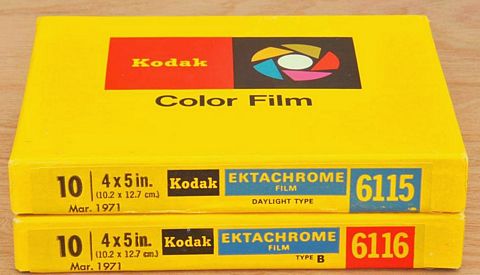 |
Ektachrome sheet film, Daylight type and Type B for process E3. Eastman Kodak changed the design of their “Color Film” boxes in late 1968. This new design replaced the “picture in a dark slide” film box (see above) plus a new sealing label with storage recommendations printed in seven languages (as shown below). The description of the film was omitted from the label. The “Film Number”, which had always been printed on the left hand side of the box along the edge, together with the emulsion number, was also printed on the right hand side of the sealing label, 6115 for Daylight Type, 6116 for Type B. Both the illustrated boxes have a “Develop Before” date of March 1971. The sealing labels were increased in size and were now placed on the long side of the box for film boxes up to and including 5 x 7 inches. This practise had been done by Kodak Limited London on their black and white sheet film boxes in the late 1940s and from 1962 to 1965 - see black and white section. These label design changes were applied to Ektachrome camera sheet films as manufactured from late 1968. |
|||||||||||||||
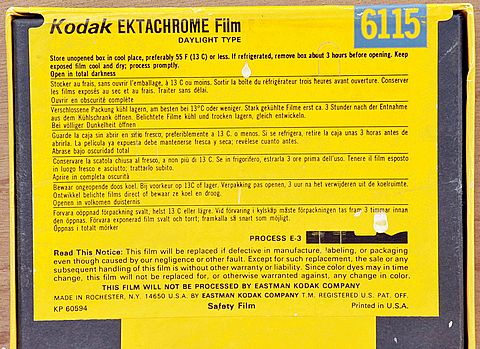 |
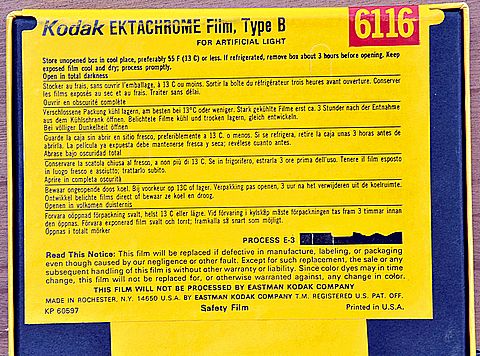 |
|||||||||||||||
 The larger (rear) label for the Eastman Kodak “Color Film” boxes (above) was short lived. By 1970 the label (see right) had reverted to being placed on the short side of the box for 4 x 5 inch and 5 x 7 inch sizes, but kept almost the same design, showing storage recommendations. Eastman Kodak have omitted the words “Safety Film” from the label. Above is shown a slightly different design for the top of the box, this one with a “Develop Before” date of January 1972. |
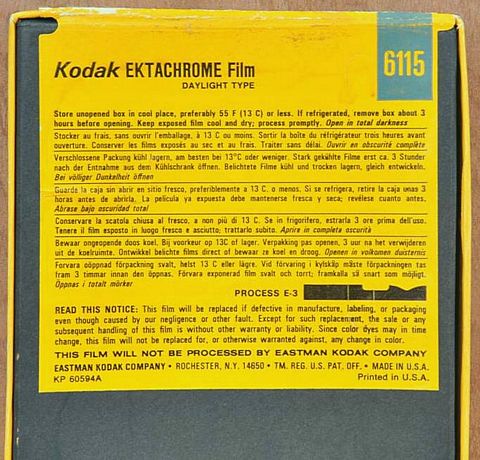 |
|||||||||||||||
| The author remembers the “large sealing” label boxes of film. He first encountered them in his last year at Art College using Ektacolor Professional Type S and Type L, Ektacolor Interneg and Ektachrome Duplicating film. At that time all Ektachrome sheet film (for cameras) sold in the UK was re-packed by Kodak Limited London into boxes that had “Colour Film” printed in red in a “blank” dark slide (see above picture of box dated JAN 1970). He's fairly certain that by 1970 all camera sheet film Ektachrome was imported from the USA without being re-packed, like the January 1972 box above. | ||||||||||||||||
| Ektachrome Professional 120 Roll Film ~ Process E3 (6115) | ||||||||||||||||
| This was the 120 size roll film version of Ektachrome 6115 Daylight type sheet film. The correct effective speed for the emulsion number stamped onto the film carton (03 348) was printed in red in the instruction sheet enclosed with the film. It could vary between 40 ASA/ISO and 64 ASA/ISO. The effective speed for film of this batch number was 50 ASA/ISO. | ||||||||||||||||
.jpg) |
.jpg) |
|||||||||||||||
.jpg) |
||||||||||||||||
| Ektachrome E3 Artificial Light Type B Sheet Film for 3200°K lamps | ||||||||||||||||
 Front labels of Ektachrome Type B film manufactured in the USA and then repacked in the UK. The boxes are of 4 x 5inch Ektachrome Process E3 Type B film for artificial light (3200°K – 3400°K), with 'Develop Before' dates of January 1970 and November 1968. |
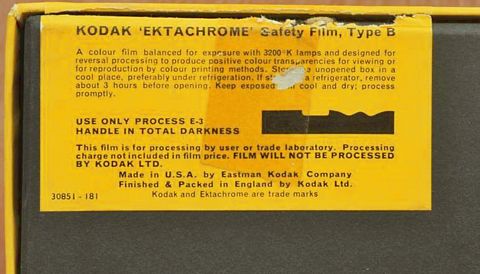 Rear label of Ektachrome Type B sheet film for process E3. As the label shows, this film was manufactured by Eastman Kodak in the USA, but then sent to the UK to be repacked and labelled by Kodak Limited, London. |
|||||||||||||||
| The practise of
re-boxing film imported from the USA began in 1965, but by 1970
Kodak in London were again importing colour film from Eastman
Kodak, Rochester, USA, in original boxes, as pre-1965. The Ektachrome
film box, daylight type, with a “Develop Before” date
of January 1972 (see further above) is one such that has not
been repacked. As far as is known, Ektachrome Daylight Type, Ektachrome Type B, and Ektacolor Print Film were the only films to be imported and repacked in this manner. |
||||||||||||||||
|
Artificial Light Type B E3 film was available for sale in the USA from 1959 in sheet film format only and in the same sizes as the Daylight Type E3 film. It was sold for the first time in the UK in 1960. Each box contained a general instruction sheet and a supplementary data sheet. Similar to the Ektachrome E1 film (see above), the supplementary data sheet gave the actual speed of the film plus filter recommendations for correcting the colour balance when the film was exposed at longer times than ½ second. The general instruction sheet gave exposure indexes for:
In the description of exposing sheets of Type B film designed for the Ektachrome E1 process (see above), the photographer was advised to increase exposure by between ½ stop and two stops, due to the reciprocity failure of the film. A different method of calculating the exposure was used with Ektachrome Type B E3 film. Typical Supplementary Data sheet for a batch of Ektachrome Type B Process E3 sheet film
*
colour balance Normally, the correct exposure was found by setting the exposure meter at the middle ASA speed i.e. 20 ASA, and taking a reading. If the exposure time thus calculated was much greater or much less than 5 seconds, and a different speed given in the data sheet related to this time, this different speed was used to re-calculate the exposure. For times much beyond 30 seconds, say over 60 seconds, a trial exposure definitely had to be made, as it was likely that the film speed would need to be decreased even further and the colour balance corrected with a higher strength filter than CC 20G. Example: Michael Talbert exposed many sheets of Ektachrome Type B E3 film and in his experience it was always best to take a “test" shot first, which would also tell the particular colour balance of the processing chemicals. In the above example, if the E3 process was tending towards a magenta balance, this might “cancel out” the results from a CC10 Green filter, making the finished transparency still slightly magenta despite exposing with the equivalent of a 15 Green filter on the lens. Thus, the "test" would give guidance of the likely need to use a stronger correction filter than CC15 Green. Other common variables which might alter the colour balance of the processed transparencies include:
BUT....given the correct exposure and processing, this film was capable of producing outstanding results, far better than that of any rollfilm or 35 mm film designed for Process E2. Ektachrome E3 Process sheet films were replaced by Ektachrome E6 sheet films in 1976. |
||||||||||||||||
|
|
|||||||||||||||||||||||||||||||||||||||||||||||||||||||||||||||||||||||||||||||||||||||||||||||||||||||||||||||||||
|
Process E-4 was introduced by Eastman Kodak Company in 1965 as a faster reversal process operating at 83 – 87°F for machine processing of amateurs’ Ektachrome films. Unlike Process E-3, there was no need for re-exposure of the partly processed film to light for reversal; instead, reversal was accomplished by chemical fogging in the E-4 Colour Developer. Films suitable for processing
in E-4 (in 1973) were: Other sheet film Ektachrome, 6115 and 6116, Ektachrome Duplicating Film, 6119 and 6120, and Professional roll films, 50 ASA, and 32 ASA, could not be processed in E4. These films could only be processed in E3. As the films listed above were
originally designed for processing at temperatures of 73 –
77°F, (Process E-2), emulsion reticulation would occur when
processing these films at higher temperatures. Therefore, two
additional baths were required, The Pre–Hardener bath
contained two powerful hardening agents, (i) Formaldehyde and
(ii) DMTF, 25 – dimethoxytetrahydrofuran. The E-4 Colour Developer contained TBAB – tertiary butylamine borane. This chemical enabled the undeveloped parts of the film, having been developed to a negative image in the First Developer, to react in the Colour Developer to form a positive image. TBAB is very toxic, and the chemical had to be handled with great care. Kodak supplied the chemical as one part of the Colour Developer, and Colour Developer Replenisher, in pellet form, to reduce any chance of inhaling any dust or powder from the TBAB when mixing the Colour Developer or it’s Replenisher. Again, the 3 gallon instruction leaflet gave precautions in handling and mixing the components of the separate parts of the Colour Developer/Replenisher. If the Colour Developer was mixed from separate chemicals, as to the formula, TBAB could be omitted. The films were then given a reversal light exposure after step 5, in the same way as in the E2 and E3 procedures, before placing the films in the Colour Develper. Although the process was initially designed for use in large tank installations and continuous processing machines, it was possible to use the E-4 process in small amateur developing tanks. Small volume kits of chemicals were made available in 1 quart size (US), and 600ccs size (UK) by the end of the 1960s. Processing
Procedure for E-4 (i) large commercial tanks (ii) amateur processing
tanks
Notes:
(ii) Processing procedure for small tanks, 2 litres or less. This was the processing procedure for the Kodak (UK) amateur E-4 kits.
Notes:
|
|||||||||||||||||||||||||||||||||||||||||||||||||||||||||||||||||||||||||||||||||||||||||||||||||||||||||||||||||||
|
|
||||||||||||||||||||||||||||||||||||||||||||||||||||||||||||||||||||||||
| The Ektachrome E-6 process began to supercede Process E-4 from 1976. Kodak stopped making Ektachrome X (a process E2 film) about 1978, replacing it with Ektachrome 64 film for the (new) E-6 process. Thereafter, all previous Ektachrome films could only be processed if sent to a laboratory still providing the lower temperature Process E-4 (or the obsolete E-2). | ||||||||||||||||||||||||||||||||||||||||||||||||||||||||||||||||||||||||
| Ektachrome Professional 64 This was one of the first E6 sheet films to be marketed in the USA in 1976 and then in the UK from 1977. The speed rating could vary from 50 ASA (ISO) to 80 ASA (ISO) and the actual speed of the film for each batch was given in the instruction sheet enclosed in the film box. |
||||||||||||||||||||||||||||||||||||||||||||||||||||||||||||||||||||||||
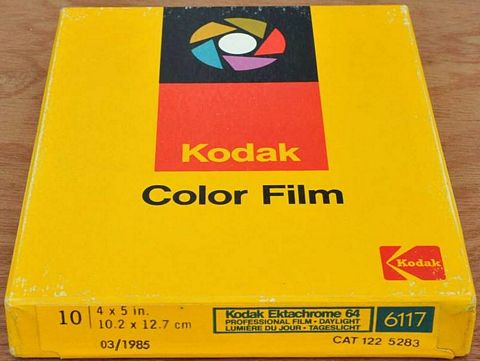 A box of 5 x 4 inch Ektachrome Professional 64 Daylight Type Film for Process E6 This box has a "Develop Before" date of March 1985. The rear label (see right) shows storage instructions in seven languages. |
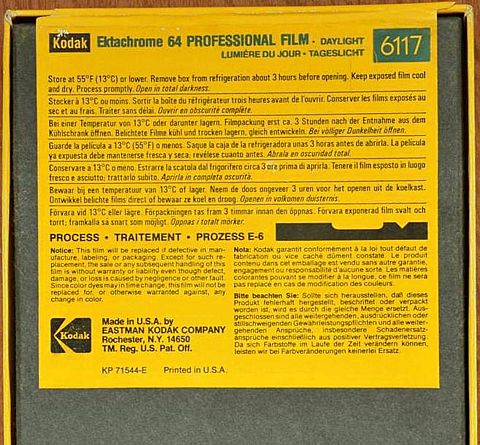 |
|||||||||||||||||||||||||||||||||||||||||||||||||||||||||||||||||||||||
|
Ektachrome
Professional film 6118 The 6118 film was designed for exposures from 1/10 second to 100 seconds. It’s speed when exposed using 1/10 second could vary from 32 ASA (ISO) to 50 ASA (ISO). An instruction leaflet dated March 1978 was enclosed in the film box (see below) stating a speed of 40 ASA (ISO) for use at ½ second, and a speed of 32 ASA (ISO) at a 5 second exposure. For critical use a trial exposure could be made, especially if the exposure estimated was over 20 seconds. In this case an exposure reading would be taken with the meter set at 20 ASA (ISO). For exposures over 40 seconds, it was essential that a test exposure was made, and this would show if any extra filtration (including the CC 5 red filter) was needed to correct the colour balance. For an estimated exposure of about 100 seconds, 10 ASA (ISO) might have been a good starting point plus a CC 10 Red filter. Ektachrome Professional film 6118 Tungsten was replaced by Ektachrome 64T Professional film in 1989. |
||||||||||||||||||||||||||||||||||||||||||||||||||||||||||||||||||||||||
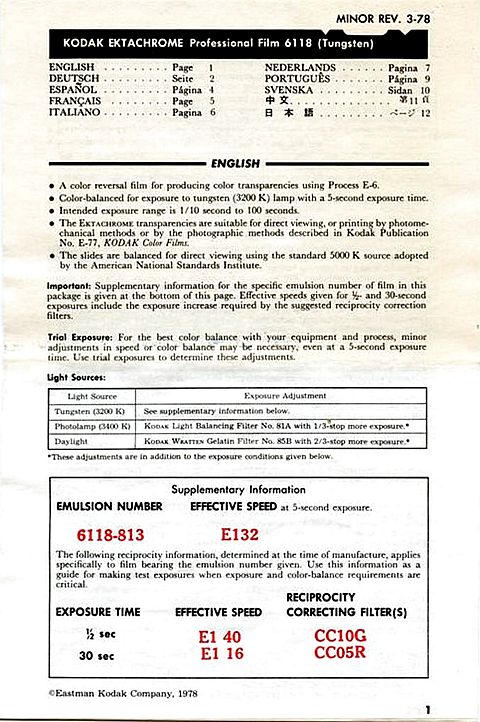 |
 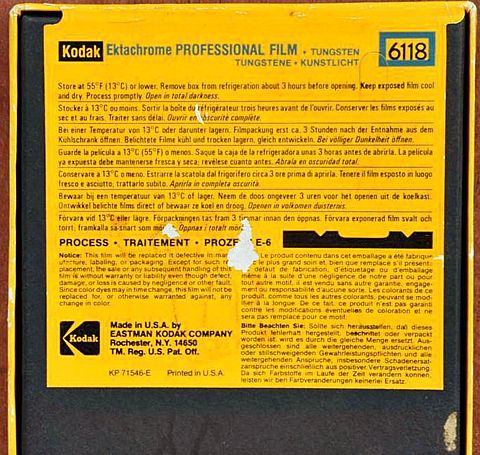 The rear label shows the “Code Notch” and storage details. |
|||||||||||||||||||||||||||||||||||||||||||||||||||||||||||||||||||||||
|
Ektachrome
Professional 100 film for daylight, Sheet and Roll Film Other features: By 1985 an 11 x 14 inch size sheet film was available as well as a 220 size roll film, 35mm and bulk 35mm in 100 foot rolls. In the late 1990s the sheet film number was changed to 7058 with the same catalogue numbers. Other Ektachrome camera films were introduced during the 1990s incorporating Kodak's T grain for much finer grain, but Ektachrome 100 Professional film continued to be manufactured using traditional technology. A part description from the
UK Kodak “Professional Products Profile” catalogue
for 1999 reads: By 2003 the film was available in 4 x 5 inch sheet film, 120 roll film, 35mm cassettes, and bulk 35mm. |
||||||||||||||||||||||||||||||||||||||||||||||||||||||||||||||||||||||||
 Front of a box of 4 x 5 inch Ektachrome 100 Professional film with a 'develop before' date of August 1987 |
 The rear label of a box of Ektachrome 100 Professional sheet film. It shows storage information and a “Code Notch” diagram. One of the first labels on which a thermometer icon was used to denote storage temperature (below 55°F, 13°C). |
|||||||||||||||||||||||||||||||||||||||||||||||||||||||||||||||||||||||
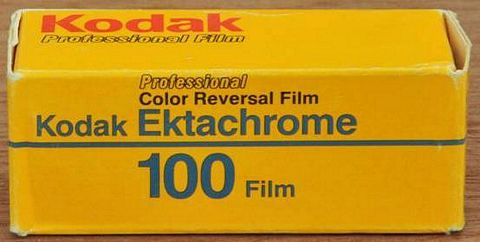 Ektachrome 100 Professional in a 120 roll film size Above is a 100 ISO (ASA) speed film and below is the 200 ISO version. |
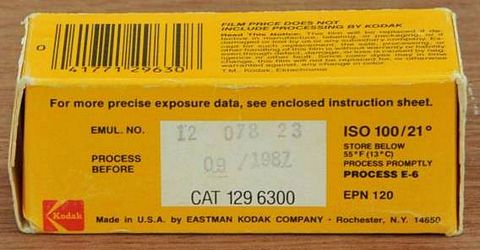 Ektachrome 100 Professional 120 film with a 'develop before' date of September 1987. The 200 ISO film below has a 'develop before' date of June 1988. |
|||||||||||||||||||||||||||||||||||||||||||||||||||||||||||||||||||||||
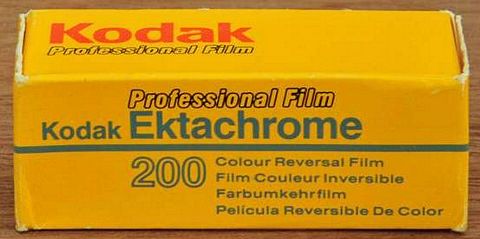 |
 |
|||||||||||||||||||||||||||||||||||||||||||||||||||||||||||||||||||||||
|
Kodak
Ektachrome E6 Processing Kits Kodak Developer
Kit Process E6 Thanks to the Canadian ebay seller 'thrifttwins' for his permission to show the following images of an Ektachrome film E6 processing kit dating from 1979 for processing any E6 films. It combines the 1977 innovation of including two 473 ml units each of First Developer and Colour Developer, plus one 473 ml unit of all the other associated chemicals. |
||||||||||||||||||||||||||||||||||||||||||||||||||||||||||||||||||||||||
.jpg) |
_cr.jpg) |
|||||||||||||||||||||||||||||||||||||||||||||||||||||||||||||||||||||||
.jpg) |
.jpg) |
|||||||||||||||||||||||||||||||||||||||||||||||||||||||||||||||||||||||
|
Kodak
Hobby Pac Colour Slide Kit for Process E6 This kit of chemicals was intended for amateur photographers to process any E6 film in small developing tanks at temperatures from 96°F to 110°F. This was the recommended temperature range for best results. However, it was also possible to obtain acceptable results from processing films at temperatures from 70°F to 95°F. The following processing sequence gives times for 96°F (35.5°C) using small capacity tanks holding half a litre of solution.
Notes:
As far as is known, the Hobby
Pac kits were discontinued in the late 1990s. In the UK in 1998
a 3.8 litre kit was obtainable for E6. The volume changed
to 5 litres in 1999, comprising of six solutions By 1992 the formaldehyde was removed from the E6 Stabilizer and the bath was re-named “Final Bath” or “Final Rinse”. E6 films were hardened in the Conditioner bath, now re named "Pre-Bleach”. The formalin was locked into the solution chemically and was released onto the film only when needed, thus eliminating the irritating smell of formalin. |
||||||||||||||||||||||||||||||||||||||||||||||||||||||||||||||||||||||||
|
Processing
Procedure for E-6 Although, at its very highest temperature of use, Process E-4 was only 10degF lower than Process E-6, an important inclusion within Process E-4 (compared to Process E2) was a 85°F Pre-Hardener stage, which toughened E-2 film emulsion layers sufficiently to withstand E-4 processing temperatures. You couldn't process E-2 Ektachrome films in Process E-4 without putting them through this Pre-Hardener step first. Since Process E-6 did not include a Pre-Hardener, because E-6 films were intrinsically designed to tolerate the 38°C E-6 processing temperature, any E-2 film put through an E-6 process would be liable to irretrievable emulsion damage; the emulsion might even separate completely from its base. For advice on how to process out of date E-2 films, see the following section. The following table provides a summary of steps for Process E-6 in a typical amateur 600ml processing tank. The times shown include a 10 second drain time at the end of each step. If your tank is not a daylight-loading model, you should load it in complete darkness, but for convenience of filling, emptying and agitating with solution, it is acceptable to remove the lid of the tank at the end of step 3. For a commercial large tank
replenished system or continuous processor, the following times
applied:
Notes:
The British Journal of Photography Annual for 1985 gives advice for processing E-6 film at 32°C (rather than the official 38°C), being the lowest temperature recommended. The BJPA text says that processing below 32°C “the permeability of the emulsion diminishes too greatly to permit adequate exchange of solutions through the gelatin”. In other works, below 32°C, the gelatin is too cold to let the flow of chemicals through to work on the bottom emulsion layers (but see the following section, where Photo Technology claimed processing to be possible down to 20°C).
|
||||||||||||||||||||||||||||||||||||||||||||||||||||||||||||||||||||||||
|
Amateur Photographer test of Ektachrome 200 for
Process E6 (January 18th 1978) The new Ektachrome 200 has significantly improved grain characteristics while offering a 1/3stop increase in speed over the former E4-process High Speed Ektachrome (160 ASA). It has improved colour reproduction with better separation of subtle hues of the same colour. The new film is not only sharper than High Speed Ektachrome, but seems to have lost the traditional blue/green bias. The makers also say that the new product gives excellent results when push-processed by one f/stop to obtain an effective film speed of 400ASA. This is one of the most useful advantages of this new film. Fast film speed ratings do, however, come with certain disadvantages - something has to be slightly sacrificed in order to achieve the speed. You'll still have to go a long way to beat the colour saturation and sharpness of Kodachrome 25, but the new film isn't far off the quality of Kodachrome 64. Professional users of the new Ektachrome 200 claim that the Professional version shows better flesh tones, neutrals, greens and browns; especially better brown tones found in wood grain and other "rich" surfaces. Professional films, though, are aimed at a specific user and therefore these films must be carefully stored in refrigerated conditions. The capacity of a film to faithfully reproduce colours can change over a period of time, so the new films aimed at the amateur take this into consideration. Amateur users have nothing to worry about if they use the film before the expiry date on the carton. However, it is reported by some users to be less forgiving, storage-wise, than High Speed Ektachrome. Processing services for Kodak Ektachrome films of the E4 process will continue to be available for an undetermined length of time. This will be until the manufacturer feels that photographers have had sufficient time to finish all their E4 films and have gone over to the new E6 films. Amateurs who wish to process their own new E6 Ektachrome films can obtain an E6 processing kit which will make 600ml of solution. At the moment the new Ektachrome 200 is available only 35mm cassettes viz: 20 exposures for about £1.58 and 36 exposures for about £2.50. In our user tests of the films
compared here, three cameras were used - a Nikkormat FTn, a Canon
AT-1 and a Fujica ST705. All three of the films were then sent
to Kodak for processing to obtain the best results. The advantage
of the new 200ASA film is only slight when compared to the former
160ASA variety, but when used at 400ASA it really does become
more important. This means that a faster shutter speed may be
used to stop action or alternatively a smaller aperture may be
used for increased depth-of-field. Due to reciprocity characteristics, some small amount of film speed is lost when using the new films with electronic flash due to the extremely short exposure time. This is also the case with exposures longer than about 1sec. The reversal part of the E6 process is a chemical one, so the film spiral need not be removed from the developing tank and held up to a bright light; in fact reversal is not complete by this method with the new films. All the processing chemicals are liquids and there are seven of them; first developer (6min), then first wash (2 min); reversal bath (2min); colour developer (6min); conditioner (2 min); bleach (6min); fixer (4min); final wash (4min) ; and finally the stabiliser (½min). Total time 32½min. The first developer temperature is the most critical for maintaining correct results. This should be 38.0 degrees C; +/-0.3 degrees. This is not easy to maintain, but it does affect density for effective film speed. To push process the film for a 400ASA rating, the only step required is that the first developer time must be increased by about six to eight minutes. Then carry on as usual. However, remember that this procedure of up-rating films increases contrast and grain and decreases exposure latitude. If you're really bold, or need to save a film under-exposed by two stops, then try extending the first development time to around 11½min. So when it comes down to colour rendition, grain, sharpness and exposure latitude, which film really scores? The short answer is that Kodak deserve a big pat on the back and a hearty "thank you" from photographers, because the new Ektachrome 200 seems to take the honours on all points. This is taking into consideration that Kodachrome has had traditionally better colour saturation and grain than the E4 High Speed Ektachrome. Gone is the traditional Ektachrome habit of changing flesh tones in shade areas to a cadaverous blue. But now with the extra speed of the 200 film and careful exposure, this new film is a winner. Keeping Kodachrome 64 on the market ensures a good medium speed transparency film, but I would guess that the majority of photographers will choose between either the sharpness of Kodachrome 25 or the speed of the new Ektachrome 200. |
||||||||||||||||||||||||||||||||||||||||||||||||||||||||||||||||||||||||
 |
The three upper shots were taken by direct summer sunlight. The left one was taken on the new Ektachrome 200 and has not only better colour saturation, but a "richer" type of colour reproduction. Colours are more accurate compared to the real flowers. The middle shot taken on High Speed Ektachrome (160ASA) and shows a bit of the traditional blue bias. The reds are slightly more washed out looking and the difference between the various hues of red are not as distinct as in the new Ektachrome shot. In the shot on Kodachrome 64 (right) the colours appear to have an overall green'ish bias. This shot has slightly more exposure so all colours appear lighter and brighter, though not quite as accurate as those seen in the new Ektachrome shot. Flesh tones reproduced in the lower pictures are more natural, yet 'rich' at the same time in the far left example on the new Ektachrome 200 film. The exposure for all three shots was exactly the same. Compared with the High Speed Ektachrome shot in the middle, the new film shows not only better colour saturation in the highlight areas (note the deeper green grass), but also in the shadow areas (note the whiteness of the blouse). The example taken on Kodachrome 64 (on the right) still has the slight overall green bias, but you will probably be able to notice that this shot appears slightly sharper due to the finer grain of this lower speed film. |
|||||||||||||||||||||||||||||||||||||||||||||||||||||||||||||||||||||||
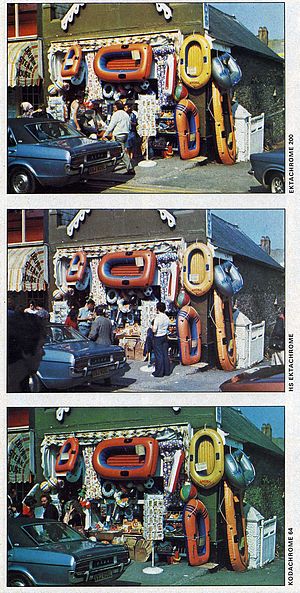 |
Colour saturation and accuracy may be seen perhaps a bit easier in these three examples. The top one was shot on Ektachrome 200. The colours are more true-to-life than in either of the other two examples. The Kodachrome 64 shot (bottom) appears slightly sharper due to its lower film speed, but shows a slight greenish colour bias. The middle shot, taken on High Speed Ektachrome, still exhibits some of the traditional blue/green colour bias for which Ektachrome was noted. This, thankfully, is gone now and even many Kodachrome 64 users will probably switch over to the new Ektachrome 200 for its slightly better colour rendition even though it is marginally less sharp. |
|||||||||||||||||||||||||||||||||||||||||||||||||||||||||||||||||||||||
| Ektachrome 64X, 100X and 400X Pro (Spring 1992) | ||||||||||||||||||||||||||||||||||||||||||||||||||||||||||||||||||||||||
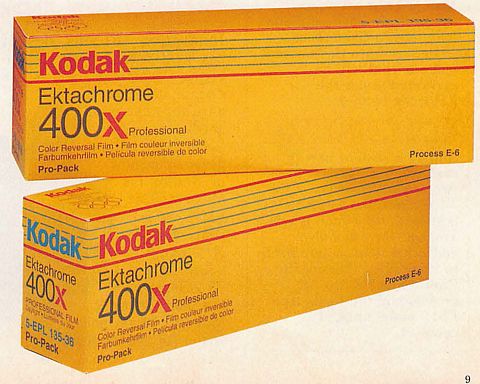 |
The following has been extracted from Amateur Photographer magazine for 22nd February 1992. It appeared in a series of announcements within a 3-page News section report from the PMA 92 trade fair held in Las Vegas. (PMA = Photo Marketing Association) That little X-tra Once again Kodak is adding
that little bit X-tra to its film range with its new Ektachrome
400X Pro. Designed for fast action shooting
in low light, the film is the first ever 400 reversal film for
professionals. The latest addition to the Ektachrome family will appear (UK) in March in 35mm with the 120 format version out in April (all refers to 1992). |
|||||||||||||||||||||||||||||||||||||||||||||||||||||||||||||||||||||||
|
Processing
Out-of-Date E-2 (and E-3 / E-4) films Possible Options are:
Photo Chrome 6 Instructions
Notes for Chrome 6:
In Conclusion: |
|||||||||||||||||||||||||||||||||||||||||||||||||||||||||||||||||||||||||||||||||||||||||||||||
|
|
|||||||||||||||||||||||||||||||||||||||||||||||||||||||||||||||||||||||||||||||||||||||||||||||
|
Type R Paper from
1955 (becoming
Ektachrome Paper in 1958) In 1954, the US Supreme Court ruled that the Eastman Kodak Company were required to release technical information on the printing and processing of Kodacolor films and Kodacolor paper. This ruling also extended to the making of colour prints produced directly from Kodachrome and Ektachrome transparency films. At that time, Eastman Kodak were making Kodachrome prints and Kodachrome enlargements from colour transparencies in any size film format up to 5 x 4 inches. Print sizes ranged from 2¼ inches x 3¼ inches to 8 inches x 10 inches. It was possible that these prints were made on a white pigmented cellulose acetate base material similar to the Eastman Kodak “Kotavachrome” prints ten years earlier. In the early 1950s, Eastman
Kodak were also making colour prints from 35mm transparencies
by first making an internegative on Kodacolor roll film, and
then printing this internegative onto Kodacolor paper. At this time, there was no actual film designed for use solely as a colour internegative film, apart from certain Eastman Color negative films being used in the Motion Picture industry. Kodak Color Print Material, Type R, originated in 1955 jointly from Kodak Pathe, at Vicennes, France, and Kodak Ltd. Harrow, UK. It was first manufactured in roll form only, in France and the UK, solely for use in Kodak processing and printing laboratories in the UK and Europe for making reversal colour prints directly from amateur photographers’ transparencies, but was later manufactured by Eastman Kodak at Rochester, New York. Eastman Kodak marketed the product in roll and various sheet sizes in the USA to colour laboratories and professional photographers. Although 'Type R' was sold in the USA to professional photographers, and possibly amateur photographers in the late 1950s, there is no obvious evidence that the paper was marketed or distributed to anyone in the UK other than colour laboratories operated by Kodak Ltd before 1965. The paper is not listed in the UK Kodak Professional Catalogue for 1964 – 1965. The paper was balanced for about 3200°K, and when making prints with an enlarger the colour balance was altered by the use of, at first, Kodak Color Compensating filters, and later Kodak Color Printing filters. Enlargers equipped with colour heads could also be used, such as, Agfacolor or Chromega colour heads. It was recommended by Kodak that the enlargers were fitted with an ultra violet filter, such as a Wratten 2B, and an Infra Red cut off filter. The Infra Red filter prevented extreme red casts in the print requiring a very high cyan filtration leading to lengthy exposure times. A first trial filtration given by Kodak was “10 Yellow plus 30 Cyan” (10 — 30). The layer arrangement was identical to Kodak Color Print Material, Type C, with the red sensitive layer on top, the green sensitive underneath the red, and the blue sensitive layer at the bottom of the pack. Unlike the material used for making Kodachrome prints, the emulsions for 'Type R' were coated onto a paper byrata–coated base. The paper was about twice as thick as Kodak single weight Bromide paper made in the UK in the mid-1950s (Bromide WSG 2S). Processing
Type R Paper, using Kodak Color Print Process P-111, from 1955 In 1960, a Kodak Color Print Processing Kit for Process P-111 could be obtained in a 3½ US gallon size. This kit contained the chemicals to make the six processing solutions, the Stabilizer being made up by the user to the Kodak formula. Separate packs of the six solutions were also available in sizes of 3½ US gallons, 10 US gallons, and 25 US gallons of each processing solution excepting the Stabilizer. A First Developer Replenisher, Process P-111, and a Color Developer Replenisher, Process P-111, were available to make 5 US gallons and 25 US gallons of each solution. This sequence is the procedure for Tank Processing, in 3 gallon tanks or larger, using the Kodak Color Print Processing Basket. Times may have been different for continuous processing machines.
Total wet processing time i.e. excluding Reversal Exposure and Drying = 74¼ Minutes Notes:-
From 1958, Kodak Color Print Material Type R, became known as “Kodak Ektachrome Paper”. |
|||||||||||||||||||||||||||||||||||||||||||||||||||||||||||||||||||||||||||||||||||||||||||||||
|
Ektachrome
Paper, from 1958 Up to 1965, Ektachrome Paper
was exposed and processed in exactly the same way as the previous
“Type R” material. There seems to have been no change
in the product apart from its name. Availability
of Kodak Ektachrome Paper in the USA in 1960 Only three sheet sizes were “stocked”; other sizes may have been subject to delivery delay or had to be ordered specially. Machine
Printing Kodak Ektachrome Paper and Processing in Ektaprint R
Chemicals; 1963 – 64 It is thought that, in 1963, there was no Kodak colour printer designed especially for making prints from transparencies. By 1967 the 'Kodak Roll Printer Model 5B-K' was available for use with Ektacolor and Ektachrome papers. A processing sequence for rolls of Ektachrome RC (Resin Coated) in the 'Kodak Continuous Color Print Processor Model 4R-3', introduced in 1964, processed at a speed of 1½ feet per minute at 85°F gave times of 3½ minutes in each solution and washes apart from the Stabilizer (2 minutes) and 'Spray Wash' (9 seconds). The processing sequence appeared in the 1969 instruction sheet 'How to use Kodak Ektaprint R chemicals' reproduced below on page 4 of the instruction sheet dated August 1969. The original process in 1964 for the Kodak Model 4R-3 may have included a 'Pre-Wet' step and a wash between the Hardener Stop Bath and R3 Bleach. The Ektachrome paper in 1964 did not have a Resin Coated base and would have required the 'Pre-Wet' step and longer washing times, but the speed of processing the paper and the temperature were the same. Ektachrome paper coated onto a Resin Coated base became available from 1969. The Ektaprint R process was introduced in 1964 replacing the old P-111 process which had been used with Ektachrome paper and Kodak Color Print Material Type R since 1955. Ektaprint R was a much faster process than P-111, operating at 85°F. It seems that the new Ektaprint R chemicals and process temperature were designed to work with the (then) new Kodak 4R-3 processor. As far as is known, Eastman Kodak never manufactured a colour print processor to work with Ektachrome paper and the P-111 process chemicals, but there may have been processors made by other companies or by colour processing labs specifically for the P-111 process. It is quite likely that the formulae of some of the components of the P-111 process remained the same within the new Ektaprint R process. Before 1964, rolls of Ektachrome paper could be wound onto Kodak Processing reels, taking widths of 3½ inch, 5 inch, and 8 inch wide paper, and processed in a P-111 3½ US gallon tank line. There were two Bleach chemicals, Ektaprint R Bleach, and Ektaprint R3 Bleach. In 1964 Ektaprint R Bleach was available in 3½, 10 and 25 US gallons. The Ektaprint R R3 Bleach was available in 25 US gallon size only. The R3 Bleach may have been made specifically for continuous colour print processors. Also in 1964, the 'Formalin Fixer' chemicals were common to both the Ektaprint R and P-122 processes as well as the later (1965) Ektaprint C process. (References: Eastman Kodak “Products for the Professional” catalogues 1964, 1965, 1968. Kodak Color Data Guide 1966. Eastman Kodak Stores, Inc catalogue 1965. Kodak Ektaprint R instruction sheet 1969). Kodak
Ektachrome Paper in the UK The Ektaprint R chemicals had to be imported from the USA along with the paper and were available in 3½ US gallon and 10 US gallon of each of the chemicals to make working strength solutions. The Ektaprint R 'Formalin Fixer' had replaced the P-111 'Hardener Fixer' and there was now an 'Ektaprint R Stabilizer'. There were also chemical components for replenishers for the First Developer, Colour Developer, and Formalin Fixer to make up 5 US gallons of replenisher for each solution.There were no Ektaprint R kits; the process was designed for large colour laboratories and D&P processing stations either for use as a 3 US gallon tank line or the quantity of 10 US gallons or more in continuous processing machines. The 'Kodak Trade Circular' for 4th January 1965, printed in December 1964, gives revised prices for all of the six P-111 chemical components. It is thought that the paper and chemicals were listed in a UK 'Kodak Finisher' catalogue, distributed only to large photofinishers, and Ektachrome paper and Ektaprint R chemicals were included for the first time in the 'Kodak Trade Circular' for March 1966, hence being termed as a 'new product' in that particular Trade Circular. Kodak Ektaprint R chemicals were included in the 'Kodak Professional Catalogue' for 1966 - 67 (catalogue dated January 1966), but Ektachrome paper was omitted. In the catalogue under the heading 'Ektaprint R Processing Chemicals' there is the note: “For processing Ektachrome Paper. For further details apply to Professional Sales Division, Kodak House, Kingsway, London WC2”. An equivalent Professional catalogue for 1968 – 69 lists the chemicals without this additional note. In 1966 – 67 the Formalin Fixer became common to the Ektaprint C process and the Ektaprint R process. The solution was available as 'Ektaprint Formalin Fixer', to make up 3 UK gallons, and as replenishers (Ektaprint Formalin Fixer and Replenisher) to make up 8.8 UK gallons and 22 UK gallons. By this time (1967), most of the Ektaprint R solutions were being sold as 3½ and 25 US gallon components except for the two developers, which were sold as to 3½ and 10 US gallons of working strength solution, and 5 and 25 US gallons of Replenishers. All the Ektaprint R chemicals were manufactured in the USA, except the Ektaprint Formalin Fixer, which was made in the UK. (References: Kodak Professional UK catalogues, 1966 – 67, 1968 – 69. Various Kodak Trade Circular booklets, 1965 – 67. Eastman Kodak Professional catalogue, 1969 - 70). Processing
Ektachrome Paper using Ektaprint R, from 1965
Total wet processing time: 48¼ minutes. Notes:
Ektachrome Paper was replaced by Ektachrome RC Paper in 1969. |
|||||||||||||||||||||||||||||||||||||||||||||||||||||||||||||||||||||||||||||||||||||||||||||||
|
Ektachrome
RC Paper, from 1969 By August 1969, Ektachrome
RC paper was available in roll sizes from 3½ inches
in width to 11 inches in width. Processing
Ektachrome and Ektachrome RC Papers using the Kodak H11-L and 16K Rapid Processors, 1965 to 1973 Processing in the H11-L and
16K Rapid Processors consisted of partly using Ektaprint R
chemicals and partly CP-5
chemicals.
Notes:
Processing Ektachrome RC Paper using Ektaprint R, 1969 to 1973
Notes:
|
|||||||||||||||||||||||||||||||||||||||||||||||||||||||||||||||||||||||||||||||||||||||||||||||
| Below is shown an Ektaprint R instruction sheet of 7 pages as would have been enclosed in the “First Developer” chemical component to make up 3½ US gallons of solution. It dates from August 1969 and was the first instruction sheet published with the new reduced process times for Ektachrome RC (Resin Coated) paper. | |||||||||||||||||||||||||||||||||||||||||||||||||||||||||||||||||||||||||||||||||||||||||||||||
.jpg) |
.jpg) |
||||||||||||||||||||||||||||||||||||||||||||||||||||||||||||||||||||||||||||||||||||||||||||||
.jpg) |
.jpg) |
||||||||||||||||||||||||||||||||||||||||||||||||||||||||||||||||||||||||||||||||||||||||||||||
.jpg) .jpg) |
The final wash time was reduced dramatically from 10 minutes to 3 minutes. There was no “Pre-Soak” step, and the wash between the Hardener-Stop and R3 Bleach was omitted. The reduction in wash times was due to the water resistant Resin Coated base which minimized the absorption of water and processing chemicals. The instruction sheet mainly refers to batch processing in 3½ US gallon tanks, but gives process times for two continuous colour print processing machines. Ektachrome RC paper was the second colour printing paper to be manufactured with a resin coated base. .jpg) |
||||||||||||||||||||||||||||||||||||||||||||||||||||||||||||||||||||||||||||||||||||||||||||||
|
Chronology: Ektachrome Papers Manufactured in the USA from 1973 to 1990
|
|||||||||||||||||||||||||||||||||||||||||||||||||||||||||||||||||||||||||||||||||||||||||||||||
|
Chronology: Ektachrome Papers used in the UK,
imported from France and USA; 1973 to 1990
|
|||||||||||||||||||||||||||||||||||||||||||||||||||||||||||||||||||||||||||||||||||||||||||||||
| Ektachrome RC Paper Type 1993 (in the USA from
1973) In the USA, Kodak Ektachrome RC paper Type 1993 replaced Ektachrome RC paper in 1973 and a shortened version of the “Ektaprint R” process was introduced in 1973 as “Ektaprint R-5" with fewer solutions and washes. |
|||||||||||||||||||||||||||||||||||||||||||||||||||||||||||||||||||||||||||||||||||||||||||||||
 |
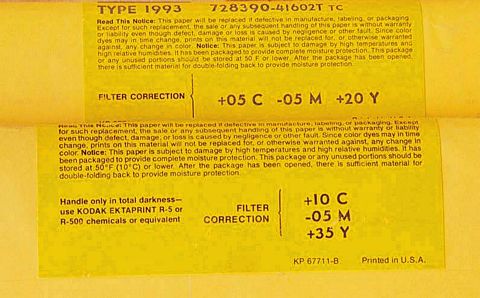 |
||||||||||||||||||||||||||||||||||||||||||||||||||||||||||||||||||||||||||||||||||||||||||||||
| Above are shown two front labels from Ektachrome RC paper, Type 1993. The top label dates from 1975 and the other label dates from 1973-74. Ektachrome RC 1993 paper was compatible with the earlier Ektaprint R seven-chemical bath process as well as the later Ektaprint R-5, five-chemical bath process. The “F” signifies a glossy surface, and the paper was also obtainable with a Silk surface, coded “Y”. | Above are the back labels to the same Type 1993 packets. The top label is of the earlier packet of 1973-74 and shows the 1993 designation. The later label now includes the processes where the “R-500” replaced the earlier “Ektaprint RD” chemicals for the Kodak Rapid Processors. Both packets show the “Filter Correction” for changing between different batches of paper. Note the high Yellow filter correction on the later packet. | ||||||||||||||||||||||||||||||||||||||||||||||||||||||||||||||||||||||||||||||||||||||||||||||
|
Processing Type 1993 using Ektaprint R-5, from 1973
Total Time: 21½ minutes. Notes:
Ektachrome RC Type 1993 paper could be dried in a drum dryer with the emulsion side out, or rolls of paper were fed through hot air dryers. |

|
||||||||||||||||||||||||||||||||||||||||||||||||||||||||||||||||||||||||||||||||||||||||||||||
|
Ektachrome
2203 Paper, in the USA from 1977 To begin with it was available in roll form only, in “Y” silk surface, but by 1980 it had fully replaced the 1993 paper and was obtainable in sheets and rolls in “F” glossy surface, and “J” smooth high lustre surface. Ektachrome 2203 was designed for processing in (then new in 1977) Ektaprint R-100 chemicals for large continuous processors working with roll paper. Ektaprint R-1000 chemicals were made available in small quantities for processing sheets of paper in drums and tube type processors. |
|||||||||||||||||||||||||||||||||||||||||||||||||||||||||||||||||||||||||||||||||||||||||||||||
|
|
||||||||||||||||||||||||||||||||||||||||||||||||||||||||||||||||||||||||||||||||||||||||||||||
 |
 |
||||||||||||||||||||||||||||||||||||||||||||||||||||||||||||||||||||||||||||||||||||||||||||||
|
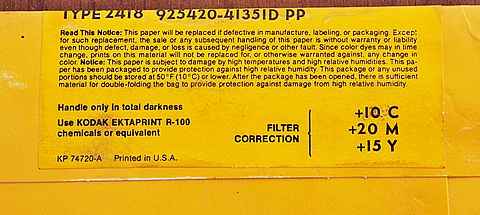 |
||||||||||||||||||||||||||||||||||||||||||||||||||||||||||||||||||||||||||||||||||||||||||||||
|
Ektachrome 2203 was principally used for “Print from Print” viz: a service mainly for amateur photographers where only the original print (not the negative) was needed to make copies or re-prints. The original print was copied by reflection directly onto the Ektachrome 2203 paper. The 'Kodak Color Print Copy attachment, Model 5S/5B-K' was available for use with Kodak 'digital' printers and Kodak S Series colour printers, such as Models 5S, 8S and 11S, for making colour copy prints from amateur's original prints onto 8.9cm wide Ektachrome paper. The print was loaded into a “print” carrier, which took the place of a negative carrier, a light was shone on the print, the shutter of the printer was opened and light was reflected off the print onto the Ektachrome paper. No negative or transparency was required to make copies or re-prints. The above reference to 'digital' printers should not be confused with the form of digital printing that became commonplace from the 1990s onwards. In the 1970s, 'digital' referred to the printers making use of in-built micro-processors, programmed (by Kodak) using a digital computer language. This gave the printers the facility to 'recognise' and adapt their exposure and colour filtration to suit a wider variety of 'non-standard' subjects. To read more detail of the Kodak MC Digital Printers, click the link here to download a pdf taken from a UK Kodak catalogue dated June 1980. By the mid-1980s, 2203 had been replaced by Ektachrome 21 and 22 papers (see below). |
|||||||||||||||||||||||||||||||||||||||||||||||||||||||||||||||||||||||||||||||||||||||||||||||
|
Ektachrome
14RC Paper, in the USA from 1972 At first the paper was processed in Kodak Ektaprint R chemicals but by 1974 the paper was being processed in a modified version of the Kodak Ektaprint R-5 process. The modified process was known collectively as Ektaprint R14. |
|||||||||||||||||||||||||||||||||||||||||||||||||||||||||||||||||||||||||||||||||||||||||||||||
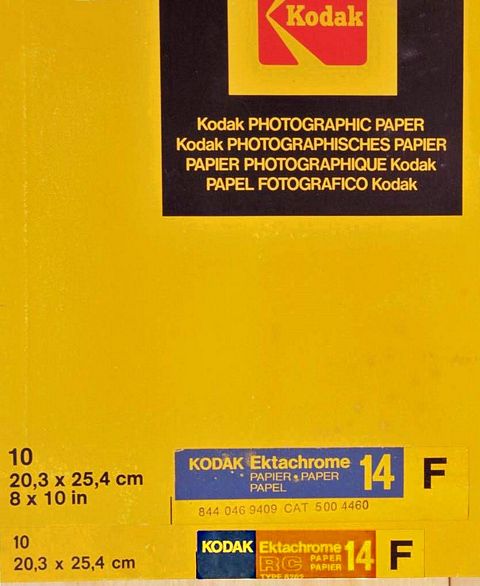 The blue label packet dates from the early 1980s. By then the “RC” and “Type 5262” had been omitted from the label. The lower label is Ektachrome 14 RC Type 5262 paper. Both papers were made in France. The “R 100” process (on the upper label; as well as Ektaprint R14) was for dish processing or small drums. Note that the “Store Below” temperature is 20°C, some 10degC (13degF) higher than the recommended storage temperature for Kodak Ektacolor papers. |
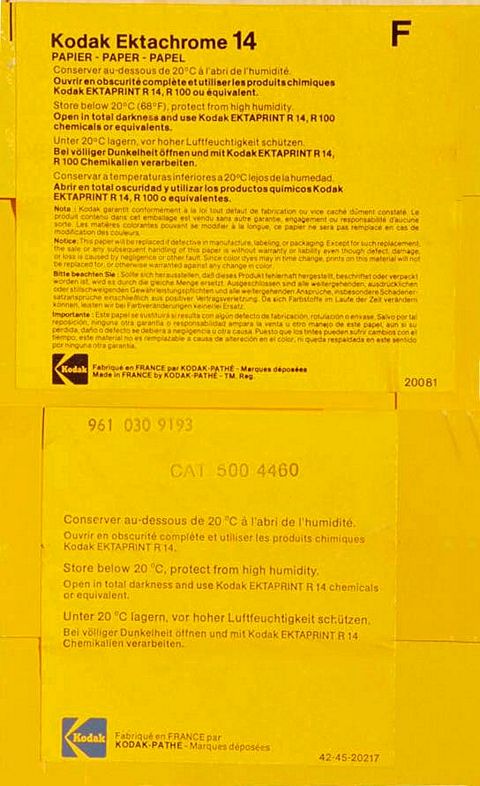 |
||||||||||||||||||||||||||||||||||||||||||||||||||||||||||||||||||||||||||||||||||||||||||||||
|
Processsing Ektachrome 14RC Paper using Ektaprint R14, from 1974
Total time: 19½ minutes excluding drying. Notes:
Ektachrome
14RC Type 5262 Paper, from 1976 Suggested three solution processing procedures at three different temperatures were published in the British Journal of Photography magazine on 15th April 1977 by Ernest C.H.Gehret. Formulae were given for the First Developer, Colour Developer, and Bleach Fix. 14RC Type 5262 was designed for making prints directly from colour transparencies. It could also be used for making copies of artworks and this included making copies of colour prints directly from a colour print, provided a method of obtaining a right way round image was employed. Starting in the mid-1970s, various colour laboratories were able to offer a “Print from Print” service to customers who sent in their colour prints instead of their negatives. This service was mainly aimed at amateur photographers, in cases where the original negative may have been lost or damaged, or where it may have been more convenient to send the colour print to the lab for additional copies. The prints obtained from the service were never as good as prints made from the negative, but provided the original print was of reasonable quality, and the contrast was not too high, a good copy could be made. A starting filtration given by Kodak for printing from transparencies using Kodak Colour Printing filters was CP40M + CP30C (40 Magenta, 30 Cyan i.e. – 40 30). A starting filtration for copying artworks or “Print from Print” using Kodak Colour Printing filters was CP10Y + CP25M, (10 Yellow, 25 Magenta i.e. 10 25 –). The French instruction sheet for “Papier Kodak Ektachrome 14” dated July 1981 gives a starting filtration of “40 Bleu” = CP40M + CP40C (40 Magenta, 40 Cyan i.e. – 40 40). Processing
Ektachrome 14RC Paper Type 5262
Notes:
|
|||||||||||||||||||||||||||||||||||||||||||||||||||||||||||||||||||||||||||||||||||||||||||||||
|
Processing
Ektachrome 14RC Paper Type 5262 in Ektaprint R14, from 1978
Total time: 24 minutes 15 seconds, not including the Re-Exposure. Notes:
|
|||||||||||||||||||||||||||||||||||||||||||||||||||||||||||||||||||||||||||||||||||||||||||||||
|
Ektachrome
19 Paper, from 1980 By this time the “RC” abbreviation had been dropped from Ektachrome papers in some of the Kodak handbooks and literature. Also by 1980, Kodak Ektaprint R14-3 processing kits were listed in the “Kodak Professional Catalogue 1980/81” published in May 1980. The kits were mainly for dish processing in a 1 litre size, or in small discard processors, such as the Kodak printank, Durst, Simmard tanks and similar, in a 5 litre size. The three solution kits contained the First Developer, Colour Developer and Bleach Fix. The “Kodak Professional
Buyers’ Guide” for January 1981 also lists Kodak Ektaprint
R14 chemicals in large quantities, including the Stop Bath and
Stabilizer for 5 solution processing of Ektachrome 14 paper
Type 5262 and Ektachrome 19 paper. It is believed
that Ektachrome 19 paper was being made in the UK, as it
is listed in the “Kodak Professional Buyers’ Guide”
for January 1981 as “Kodak Ektachrome 19 Paper, F and N. Processing
Ektachrome 14RC Type 5262 and Ektachrome 19 Papers in Ektaprint
R-3, from 1980
Total time: 24 minutes 30 seconds, not including the Reversal Exposure step. Notes.
|
||||||||||||||||||||||||||||||||||||||||
|
Ektachrome
22 Paper, from 1984 Below are shown images of the front and back labels from a box of Ektachrome 22 paper. This box dates from the mid to late 1980s. The rear label (right, below) shows storage and handling information, catalogue number, and surface F = Glossy. It was still being sold in 1990 but was replaced by Ektachrome Radience paper in 1991. It is believed that all Kodak reversal colour printing papers since Ektachrome 14 paper were being manufactured in France by Kodak-Pathe. The Eastman Kodak 1992 catalogue for the USA lists Kodak Radience paper as the first type of paper in the “Radience series”. Ektachrome Radience III paper was one of the last colour printing papers to be manufactured by Kodak-Pathe for producing prints directly from colour transparencies without the use of an internegative. Production ceased in 2003 due to increasing numbers of photographers using colour negative films for digital colour printing onto colour negative print materials, or obtaining prints digitally by down loading their pictures from solid state memory cards for ink jet printing. |
||||||||||||||||||||||||||||||||||||||||
 |
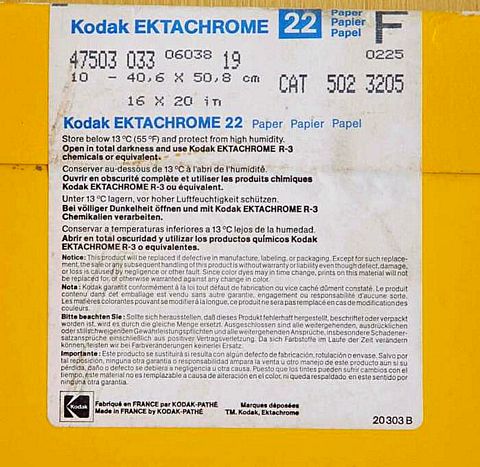 |
|||||||||||||||||||||||||||||||||||||||
| Ektachrome Radience III, from 1997 | ||||||||||||||||||||||||||||||||||||||||
|
Kodak Ektachrome Radience III paper was introduced in 1997 as a colour reversal print material for processing in Ektachrome R-3 chemicals, Ektachrome R-3 LU (Low Utilisation) chemicals, and Ektachrome R-3000 chemical kits. The paper was available in Glossy surface (F), and Semi Matt surface (N). In 2003, the available sizes for sale in the USA ranged from 8 x 10 inches to 30 x 40 inches in sheets, and 3½ inches width to 50 inches width rolls of paper. The UK catalogue lists a much more limited range of sizes. The rear label (right, below) shows a trial starting filtration of 20 Cyan, 10 Magenta and 0 Yellow. This filtration was common to all batches of Ektachrome Radience III paper and did not apply to any specific batch. The same filtration was given in the Technical Data sheet. The Technical Data also gave typical Tri-Colour exposures, viz: Red Kodak filter No.29 4seconds. It seems that Radience III was the last reversal colour paper made by Kodak. By 2003, colour prints were being made digitally onto colour negative papers and Kodak were making colour negative papers specifically for digital printing, see Kodak Professional Supra Endura on the Ektacolor web page. |
||||||||||||||||||||||||||||||||||||||||
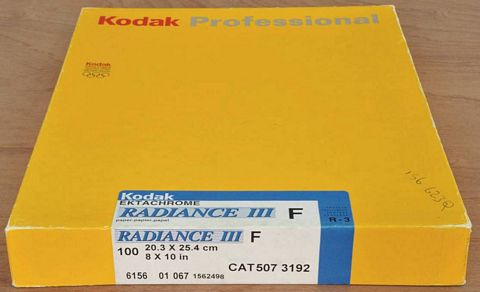 |
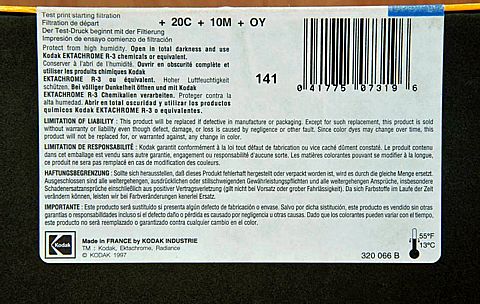 |
|||||||||||||||||||||||||||||||||||||||
|
|
||||||||||||||||||||||||||||||||||||||||
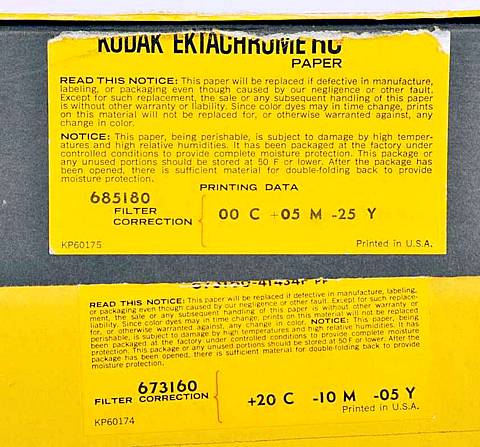 |
Michael Talbert took opportunity in early 1971, while in his final year at Art College, to make some prints using Ektachrome RC reversal paper. Most were from 5 x 4inch Ektachrome Process E3 sheet film transparencies. He printed these to 10 x 8inch for his final College Portfolio. He used the college's Beseler black & white enlarger equipped with an Agfa colour head (similar to the blue coloured Agfacolor head here). Each packet of Ektachrome RC paper was marked with a + and – filtration value of Cyan, Magenta and Yellow. These figures were given for working out the filtration when changing from one batch of paper to another (see photograph alongside, being two labels from the back of packets of Ektachrome RC paper showing “Filter Correction” for altering the filtration when changing batches of paper). A six page instruction leaflet was included in every packet of Ektachrome RC paper which gave a trial starting filtration of 25 Magenta and 10 Yellow, made up of Kodak Colour Printing filters. Using the Agfa colour head, Michael found himself using a very low Yellow filter setting and a Magenta filter varying from 10 to 87. A few prints were made with a low Cyan filter setting and a high Magenta filter. (Agfacolor head filter units were approximately two thirds the strength of Kodak Colour Printing filters). Around this same time, Michael was also making prints from colour negatives on Ektacolor Commercial paper using the same enlarger. Hence, it was easy to make comparisons between the two different types of colour print. He found that the Ektachrome RC paper was at least a stop faster than Ektacolor Commercial, and was also much more forgiving to exposure errors |
|||||||||||||||||||||||||||||||||||||||
|
When filtering Ektachrome RC paper, it was necessary to add or subtract 20 to 30 filter units on the Agfacolor head to correct a fairly strong cast. Half this filter change, or less, was sufficient to correct the same strength of colour cast on Ektacolor Commercial paper. Filtrations on Ektacolor Commercial paper were normally very high Yellow and high Magenta values. Handling and Processing Ektachrome RC was slightly thicker than Ektacolor Commercial, handling like a sheet film with more rigidity than a double weight black and white paper. All prints were processed on a Kodak Rapid Color Processor Model H11-L, and took over 15 minutes wet processing time for one 8 x 10inch or one 11 x 14inch prints. Test strips were processed up to the Bleach stage, washed briefly, and dried for assessment. It was easier to judge colour casts and exposure density after drying as, when wet, Ektachrome RC prints took on a blue appearance and looked too dark. |
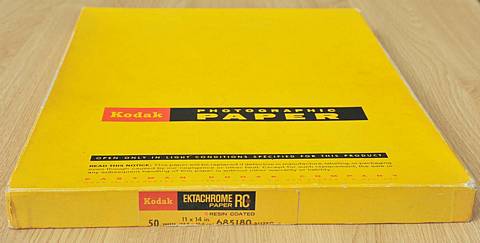
|
|||||||||||||||||||||||||||||||||||||||
|
Two of Michael's 8 x 10 inch Ektachrome RC prints have survived from 1971. Looking at them closely they both give the impression of being slightly unsharp, compared with an equivalent size print on Ektacolor or Agfacolor paper. The most noticeable defect in both prints is the lack of shadow detail. The shadow areas seem to be very dark, detail almost disappears in one print. Highlight detail is reproduced well, and both prints have good, if not excessive contrast. The contrast level on Ektachrome RC paper was much higher than Kodak Ektacolor Commercial paper; prints appeared much “brighter”. Blacks were very dense, with no hint of colour cast, but this is true of most reversal materials and duplicating films. A clean white without a colour cast was almost impossible to reproduce, mainly due to very minor fluctuations in first and colour development times and temperatures on the H11-L machine. As Ektachrome RC paper had so much latitude to filtering, it was difficult at times to “home in” on a filtration which gave no colour cast in the print. This may have been partly due to Michael's inexperience of colour printing at that time, but also he was trying (in his final college year) to become proficient with a variety of colour paper and film material, plus attempting to produce the occasional colour internegative. After leaving Art College, Michael found he never made prints on reversal printing material at any colour laboratory that he worked in, as nearly all professional colour laboratories made prints from transparencies via an internegative. This way of working had several advantages. The contrast of the resulting print could be changed according to the contrast of the transparency when exposing the internegative. Also, the shadow to highlight balance could be altered by varying the filtration of the internegative at the time of exposure. Very little contrast variation was possible when processing a colour reversal paper. If the development times were shortened, to hopefully give a softer contrast print, other problems occurred, such as less dense blacks, or colour contrast differences, e.g pink highlights and green shadows. Another reason why internegatives were preferred is due to processing costs. Internegatives could be processed through an existing C-41 processing machine, together with camera sheet and roll films. A separate processing line or machine was necessary to process reversal colour paper, and the machine could not be used to process any other type of material. |
||||||||||||||||||||||||||||||||||||||||
|
|
||
|
What is Duplicating?
There are other ways of making copies of colour transparencies, but this section describes the procedure and types of films when copying (duplicating) onto reversal films, in which the end-product, after processing, is a transparency. Many years ago, duplicate transparencies
were being made from “Reseau” or “Screen”
colour photographic plates and films by re-photographing them
onto another “Reseau” plate. The reader who is interested
in such early methods, would be advised to find a copy of the
book : Kodachrome
as a Duplicating Film In 1941, Kodachrome Duplicating Film Type
5265 was used specifically for duplicating 16mm Kodachrome motion
picture film. It is possible that a similar type of film was
used for copying 35mm Kodachrome slides. In Chapter 16 “Duplication”, he states that “Kodak have recently developed a special material for the duplication of Kodachrome, but this is not yet available for general use” The material being referred to is most likely “Kodachrome Duplicating Film Type 5265” (see above). He goes on to state that, in the USA, Eastman Kodak were offering “a special 35mm duplicating service by which masked copies of Kodachrome originals might be obtained. These special duplicates are known as Kodachrome Duplicates M” This probably refers to the service where Eastman Kodak were printing large sheet film transparency duplicates from Kodachrome 35mm originals, in which case a black and white negative contrast mask was first made from the transparency and then this mask was combined with the transparency when printing the duplicate to reduce contrast. For same size duplicates, i.e. 35mm to 35mm, the author believes Kodak didn't use any masking system. For an explanation of the term 'masking', see the next Section. Original Kodachrome Professional sheet film transparencies may have been printed directly onto ”Kodachrome Professional Type B” sheet film, using an enlarger to make the exposures. At that time, the Type B sheet film was manufactured in sizes up to 11inches by 14inches. From the late 1950s there were various Kodachrome films on the market specially made for duplicating transparencies. One of them (from 1960) was “Kodachrome Film for Duplicate Printing, Type 5294”, sold in 50 foot or 400 foot lengths, and balanced for tungsten illumination. Being Kodachrome, it had to be processed by Kodak. The price of the film included processing, but the processing plant required it returned in lengths longer than 15 feet. Duplicating
Transparencies by the Unsharp Mask Technique Normal colour film, as used in cameras, is designed to make an accurate reproduction of natural colours in bright or hazy sunlight, or in correctly balanced artificial light depending on the type of film, Type A or Type B. The contrast of the film is matched to average daylight scenes or artificial studio lighting, and will reproduce the natural contrast in such scenes provided the film is processed according to the manufacturers’ instructions. When the same film is used
to make a reproduction of an existing photographic image (colour
transparency or colour print), the camera film cannot accurately
reproduce the colour in the image being copied, partly: If camera film is used to make a reproduction transparency i.e. duplicate, it is likely that accurate reproduction will be impossible, due to certain pastel colours shifting towards the principal colour in their make up, such as pinks going too red, or greens going cyan. It is usually impossible to correct these colour shifts by using colour printing filters. Also, with a contrast increase, highlights burn out, and shadows turn black and detail is lost. The only way camera film can
be used to make duplicates is by making a black and white negative
contrast mask and then printing the transparency/mask combination
onto camera sheet film. The purpose of the mask is
to hold back some of the light from the original's highlight
areas, giving the shadow areas of the duplicate transparency
more exposure, thus lightening the shadows in the duplicate. Eastman Kodak published an article on this procedure in the 1950s. This was a 12 page booklet entitled: "Making Duplicate Transparencies in Sheet Film Sizes”, No.E 28, published in 1956. Over forty years ago, the author attempted to make some duplicate transparencies by this method, but found it was much more difficult than by using duplicating film. Most of the difficulties arose when trying to achieve the correct contrast on the black and white mask, but he could see that, if he had persevered, the duplicates made would have been of very high quality. As far as he can remember, he made three or four 5inch by 4inch duplicates, and at least one 10inch by 8inch duplicate, by the masking method, but as the price of the camera film was at least three times the price of normal duplicating film, he decided to give up the masking method because the cost (in time and materials) was prohibitive. The economic answer was to use a 'Duplicating' film (see next Section) designed specifically for producing duplicate transparencies without the need for masking. Early
Ektachrome Duplicating Materials In the case of a transparency of extreme contrast it was possible when processing the duplicate, to decrease the First Development time slightly, but this would often lead to colour balance changes, poor blacks, and a loss of saturation in the colours. If it was especially important to make a good reproduction of a transparency with an extreme contrast range, a black and white 'unsharp mask' would have to be made (see above) even when using Duplicating Film. Another way to duplicate such a transparency would have been to make an internegative from the transparency where the contrast could be changed when exposing the internegative film, and then printing the internegative onto Ektacolor or Vericolor Print Film. The earliest reference that Michael Talbert has found to any kind of Ektachrome Duplicating film is a short paragraph in the British Journal of Photography Almanac (BJPA) for 1951. In the “Epitome of Progress” section it states that Eastman Kodak have introduced an “Ektachrome Duplicating Film”, designed for making duplicate transparencies directly from Kodachrome and Ektachrome original transparencies. The author goes on to say that “the quality of these duplicates is claimed to be equal to that of the original transparency.” Unfortunately he omits to tell us what film format the new duplicating film is, i.e. 35mm or sheet, or any other useful details about the film. Michael possess a great many publications by Eastman Kodak company, plus many books on colour photography and processing colour films dating from the 1950s, but cannot find any other reference to this duplicating film in any of these publications, so perhaps this was a premature announcement of material that didn't, at that time, become commercial. Kodak
Ektachrome Reversal Print Film, Type 5386 In the UK the film was obtainable in 35mm size only in 100 foot lengths. It was known as “Eastman Ektachrome Reversal Print Film, 5386” by the late 1960s. There was an additional size of 46mm wide film, without perforations, sold only in the USA. Type 5386 was replaced by Kodak Ektachrome Slide Duplicating Film, Type 5028, in 1972 for processing in Process E4 although both films were being sold concurrently for a time. Kodak
Special Color Duplicating Film, SO-271 This film was essentially a sheet film version of 35mm Ektachrome Reversal Print Film, Type 5386, and was cut from the same film stock. The sheet film had the same base thickness of 0.005 inches, thinner than the standard Ektachrome camera sheet film of 0.007 inch thickness. As there was no gelatine backing on the film, it was easier to retouch on the base side of the film. In the UK the film was stocked in an 8 x 10 inch size only, but sizes up to 16 x 20 inches could be obtained by special order. In 1966, the Photographic Department of the Ford Motor Company in the UK were making 900 duplicates a week using the SO-271 film, having previously made duplicate transparencies by making black and white masks and then exposing onto Ektachrome camera Process E3 sheet film. Duplicating Film SO-271 became Kodak Ektachrome Duplicating Film (6119) in 1967 without any changes to the film. Ektachrome
Duplicating Film, from 1967 The film was balanced for tungsten illumination and could be used for contact printing or enlarging. Handling was in total darkness; no safelight was permissible. A supplementary data sheet was included with each box of film giving the correction filters, and a suggested increase or decrease in exposure (calculated in stops), from the “normal” exposure, or the exposure compared with the last batch of film used. A four page instruction sheet suggested a trial exposure, (if using the film for the first time), of 1 second, and to make three or four test exposures at this time, each exposure being 1 stop apart. The instructions also mention that the exposure time could be increased, but if so the quality of the duplicates may be affected because of the reciprocity failure of the film. Processing was in E3 chemicals, (see above), but dedicated First Developer and Colour Developer were recommended for the duplicating film if processing was carried out using an existing E3 process line. Below are shown boxes for the Ektachrome Duplicating films, 6119, 6120, and 6121 for the E3 and E6 processes. As shown on the 6120 box, by 1971 most of the Kodak sheet films, black and white, and colour, were being packed without the interleaving sheets of black paper, starting with the American made films. The supplementary data, included in the instruction sheet for the 8 x 10 inch 6121 E6 duplicating film, suggests a filtration of 30Y+20C, a 30 Yellow and a 20 Cyan filter, (30 – 20), as a starting filtration assuming the film was exposed for a 10 second trial exposure. A supplementary data sheet, packed separately from the instruction sheet, for the Ektachrome Duplicating film, size 8 x 10 inches dated “JAN 1970”, gave 20M+30Y, a 20 Magenta filter and a 30 Yellow filter, (30 20 --), as a starting filtration. The sheet also advises that all exposures must be increased by 1 stop. This assumes the exposure time given for a test duplicate is 1 second for an emulsion rated at “normal” speed. Because of differences in exposing equipment, light sources, and processing techniques, the filtrations given in the supplementary data sheets were only of use for calculating the new filtration when changing over from one batch of duplicating film to another. |
||
 |
|
Ektachrome
Duplicating Film 6119 from 1969 The “Kodak Products for the Professional” catalogue of 1969 for distribution in the USA classifies this film as “Kodak Ektachrome Duplicating Film, Process E3, (for use with 3200°K lamps)". It was available in the USA in five sheet sizes, from 4 x 5 inches to 16 x 20 inches. The catalogue was printed in early 1969 before the 6119 code was attached to the name of the film. |
|
|
|
|
|
|
was packed into the then new Kodak “Color Film” boxes (see left) with the label fixed to the long side of the box, plus with the addition of the film number 6119 now printed onto the label. |
|
Ektachrome
Duplicating Film 6119 in use The duplicating film was balanced for a 3200°K light source and the instruction sheet enclosed in each box of film suggested an exposure time of 1 second. It also stated that the exposure time could be increased, but the quality of the duplicates would be adversely affected. The author has recently (Feb 2013) found that "Amazingly, four of my 8 by 10 inch duplicates which I made on the thin base 6119 film have survived. They don’t seem to have faded much either, having been dark stored for the past 42 years !" The film speed was extremely slow when used in the Beseler enlargers. A 5 inch by 4 inch Ektachrome transparency enlarged to make an 8 inch by 10 inch duplicate would require an exposure time of around 20 to 25 seconds at F5.6 to F8, F5.6 being the largest available aperture. This exposure time was 25 times the recommended length of exposure. A slightly over exposed (hence too little density) 6 cms by 6 cms (2¼ inch square) transparency, enlarged to 8 inches square, required 30 seconds exposure, plus an increase in the first development time to prevent the duplicate from becoming too dark. This was the only 6 cms by 6 cms transparency from which Michael attempted to make an enlarged duplicate, and was done because the original transparency was slightly over exposed. The filtrations on the Agfacolor Head, (see the Agfacolor section), and using the Kodak Colour Printing filters, were mainly in the region of 80 yellow to 110 yellow, and from 55 magenta to 85 magenta. The filtrations were fairly similar between the enlargers but the bulbs in the enlargers were different. The Agfacolor heads took a massive bulb, 5 inches long and 250 watts, while the Beseler black and white enlargers took a 150 watt bulb. Thus, it is probably pure chance that the filtrations were similar, considering a) the different types of filter, CP filters in the Beseler and the Agfacolor head filters, plus b) the colours of the inside of the enlargers. Hence, maybe the colour of condensers or the characteristics of the enlarging lenses, coincidentally made the colour of the light coming out of the enlargers a close match. Increasing the exposures to over 20 seconds caused the duplicating film to turn green. Increasing the magenta filter in the Agfacolor Head or adding more Kodak CP magenta filters to the filter pack, only served to increase the exposure time further. Because of this increase in exposure, it was impossible to make 10 inch by 8 inch duplicates from 6 cms by 6 cms transparencies, unless they were over exposed (low density) like the example referred to above. Another problem was Contrast. Unless the transparency to be duplicated was of abnormally soft contrast, almost all duplicates exhibited an increased contrast compared to the original, despite the duplicating film having low contrast characteristics. |
||||||||||||
|
Lowering
the Contrast by “Flashing” Directly after the main exposure, the transparency was removed from the negative carrier and a Kodak Wratten Neutral Density filter, No.96, was placed under the lens of the enlarger. The duplicating film was then exposed again for the same time as the main exposure, leaving the CP filters in the enlarger, or the same filtration dialed in to the Agfacolor Head. Occasionally the “flash” exposure gave a colour cast to the shadow area of the duplicate. This could be corrected by adding a CP filter, or increasing the appropriate dial filter setting on the Agfacolor head, when exposing the duplicate to the flash exposure. A magenta filter would correct a green cast in the shadow area, a cyan filter would correct a red cast, and so on. This method worked fairly well on the whole. All the duplicates Michael made in those days on 6119 Duplicating film were exposed with a "Flashing" exposure. A typical duplicate exposure
would be written: The flash exposure could be varied according to the amount of contrast reduction. The Flash exposure was 1/100 of the main exposure if both exposures were equal (due to the light reducing power of the Neutral Density filter No.96). Lowering
the Contrast by Chemical Means The Colour Developer was altered
by adding: Processing
the Duplicates The duplicating film had to be handled carefully when exposing and processing. Marks and scratches on the film were common, mainly being caused during processing. Because of the very low speed of the duplicating film, necessitating much longer exposures than recommended, very dark shadow areas showed no detail in them and reproduced as completely black. The black areas looked greenish when viewed with a fairly strong light source behind the duplicate. (Footnote: Many years later the author used this odd characteristic, of completely black shadows with no detail in them, while making a digital colour print of a simulated 1920s fashion picture. The colours were desaturated, contrast was lowered, and the shadow areas were made progressively darker until the deepest shadow areas became completely black. Colour prints actually produced in the 1920s were made from colour separation negatives photographed directly from the subject. Tri Chrome Carbro and Jos Pe were two principal methods for making colour prints in those days. The Jos Pe method of making colour prints was a very early version of a process similar to Kodak Dye Transfer). |
||||||||||||
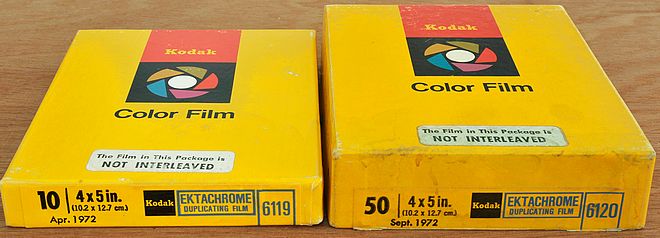 |
Ektachrome Duplicating films 6119 and 6120 with “develop before” dates of April 1972 and September 1972. The 6120 film was a much improved version of 6119, being at least three stops faster. It had a base of the same thickness as Ektachrome camera sheet films. In the USA the new 6120 film was obtainable by the end of 1971. Below are shown the back labels. They are almost identical apart from the film number and a new code notch for 6120. This was the final label for 6119 and the first label for 6120. |
|||||||||||
   |
||||||||||||
|
Ektachrome
Duplicating Film, 6120 from 1971 Like the previous duplicating film, processing was carried out in E3 chemicals with a shorter First Development time and a higher agitation rate in the First Developer. The film could be processed in the same First and Colour Developers of an existing E3 processing line but, because of the shorter time in the First Developer and higher agitation rate, it was recommended that the duplicating film was processed separately from the regular camera sheet films. The First Developer time was 6 minutes at 75 +/– ½°F when processing the duplicating film The new film had the same base thickness as the E3 camera sheet films. Therefore, if need be, the duplicates could be butted up together with the camera sheet films for use in displays. In use, trial exposures of 10 seconds were suggested using tungsten illumination, exposing with the filters recommended in the supplementary data sheet enclosed with each box of film. Three exposures of 10 seconds each were made at three intensity levels, usually at one stop intervals, varying the lens aperture rather than the time. In the U.K. in 1973, the film was available for sale in sizes from 4 inches by 5 inches to 12 inches by 15 inches in quantities of 25 sheets per box. It sold for a somewhat lower price than the Process E3 camera sheet films. Duplicating
Film 6120, In Use Most of the duplicates were made on a Durst 138 enlarger with a CLS 300 colour head, and some duplicates were made, in 1972, on a De Vere “75” floor standing black and white enlarger fitted with an Agfacolor head. The Durst 138 negative carrier accommodated negatives or transparencies from 35mm to 4 inches by 5 inches. The enlarger was equipped with two lamps, one each side of a mirror box, containing two mirrors, each angled at 45 degrees directing light downwards through a diffuser, placed on top of a vertical “mirror tunnel”. At the bottom of the “mirror tunnel” was another diffuser, with the negative carrier underneath the diffuser. A set of dichroic filters, yellow, magenta and cyan, were fitted in front of each lamp, the lamps, filters, and mirror box were contained in a large rectangular box at the top of the enlarger. Three control knobs outside the box were used to dial the dichroic filters in and out of the light path. The maximum filtration that could be dialed of each colour was 80 units. It is difficult to make comparisons with strengths of filters but the filter strength on the CLS 300 colour head were slightly stronger than the Kodak Colour Printing range of filters and possibly twice the strength of the filters fitted in an Agfacolor head (see Agfa section). A Kodak Colour Printing filter of 50 units would have been the equivalent of dialing in 35 units into the CLS 300 colour head. Duplicating
Film 6120, Exposure Times Although exposures below 7 seconds tended to decrease the contrast of the resulting duplicate, long exposures made little or no difference to the contrast, but as the film had a fairly high speed, exposure times beyond 25 seconds were very rare. Duplicating
Film 6120, Filtration Techniques When making duplicates on the Durst 138 enlarger it was usual to dial all three filters into the colour head, starting with a filtration for a trial duplicate of 60 20 40 (i.e. 60 yellow, 20 magenta, 40 cyan). Printing with three filters had two advantages.
Note: Neutral density in filtrations means that a certain amount of “Gray” colour is present in the filtration. A filtration of (say), 65 15 50 has 15 “gray”, in it. The filtration without the "gray" would be 50 – 35. (i.e. 50 yellow, zero magenta , 35 cyan). The “gray” colour does not alter the colour of the duplicate, but does (slightly) increase the printing exposure required. This 3 colour method of filtering the colour balance of a duplicate (or colour print), went against the advice given to beginners in colour printing where the vast majority of books, manuals, photographic magazine etc. articles on the subject recommended that at least one printing filter should always remain at zero, i.e. such articles advised that it was never necessary to dial all three colours into the colour head, or place three different colour filters in the filter draw. However, the 3 filtration method was a technique which Michael used for convenience with 6120 Duplicating Film, though he never used this technique when making prints from colour negatives. But the 3 filtration method would have worked when printing on any type of multi-layer colour material, as long as the printer realized that any filtration with three colour printing filters has an element of "gray" within the filtration which must increase the printing exposure compared to using the 2 filtration method. The duplicates exposed on Ektachrome Duplicating Film, 6120 were of very high quality and it was possible to make a much improved copy from an under-exposed original transparency, improving both the colour and the density. Over-exposed originals could be improved, but not to the same extent and the results often showed colour mis-matches from high-light to shadow areas. (Pink highlights, green shadows as an example). Even so, the 6120 duplicating film had far more latitude in exposure compared to making colour prints from colour negatives. Ektachrome
Duplicating Film, 6121 from 1977 In use, it was similar to the previous 6120 E3 duplicating film, with approximately the same speed using the same exposure times. (10 seconds for a trial exposure using tungsten illumination). The film could be processed with E6 camera films, as there was no need for a reduced First Development time. The First Development time for all E6 films was 6 minutes at 100 +/– ½°F. In the U.K. the “Kodak Buyers’ Guide” for January 1981 listed film sizes up to 16inches by 20 inches in 25 sheet boxes. By the mid-1980s some sizes were available in 50 sheet boxes. Chronology for Ektachrome Print Films, 1981 to
1987; 3-Bath Processing
Ektachrome
Duplicating Film Type K, 7121 from early 1990s It was available in sheet film sizes up to 8inches by 10inches with larger sizes to special order. 10 seconds trial exposure was recommended using tungsten illumination. All Duplicating Films were to be handled in total darkness; no safelight was permissable. |
||||||||||||
|
Michael
Talbert He didn't do anymore colour processing until mid-1969, being his first year at Art College, when he processed an Ektachrome roll film in the Medway College colour darkroom. Then, later on that year, he started colour printing. During his second year at Art College he processed many Ektachrome sheet, roll and 35mm films in a three gallon tank line. The sheet film, (4 x 5inch), used the E3 process, and the roll and 35mm films used the E2 process. Separate developers were required for each, but the rest of the solutions were common to both processes. He started making colour prints in 1969, using Kodak Ektacolor Commercial paper. He was a photographic colour printer in the 1970s, printing colour negatives mainly onto Agfacolor paper. He also had experience using about 10 types of Kodak paper, plus other makes, Gevacolor, Fuji, Paterson, Konica. Michael now sets up and takes “Retro” fashion pictures, but prints them digitally. |
|
|
|



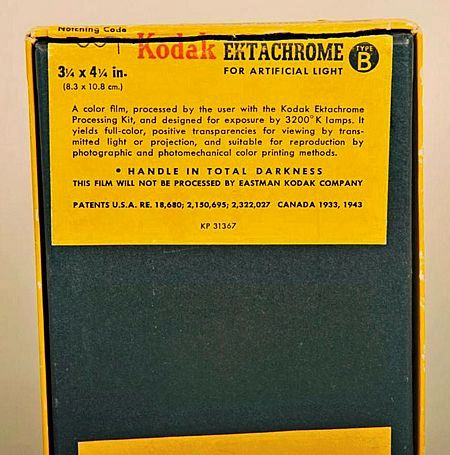

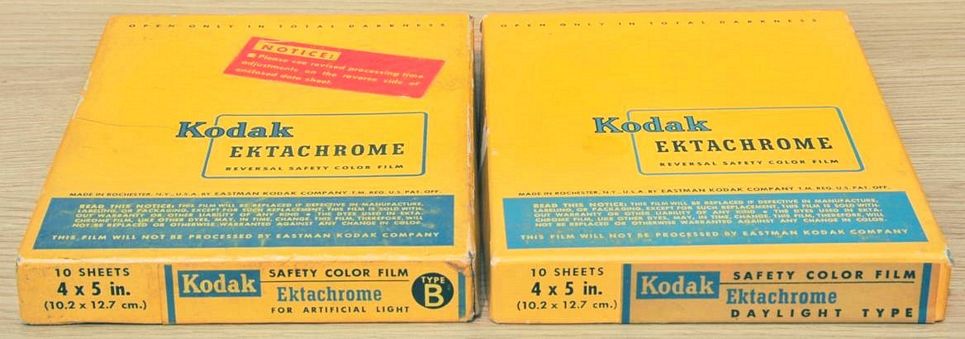
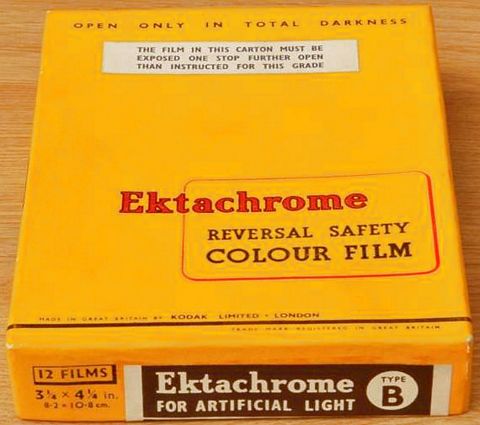
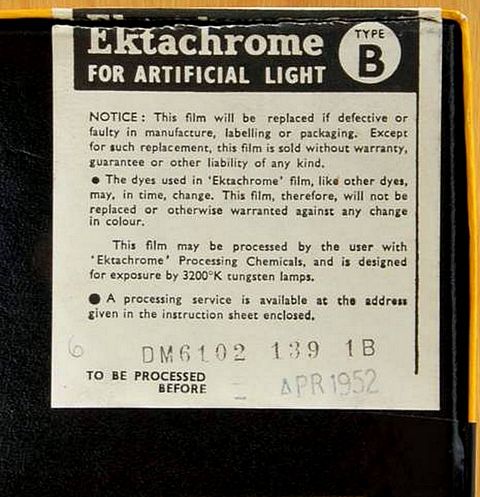
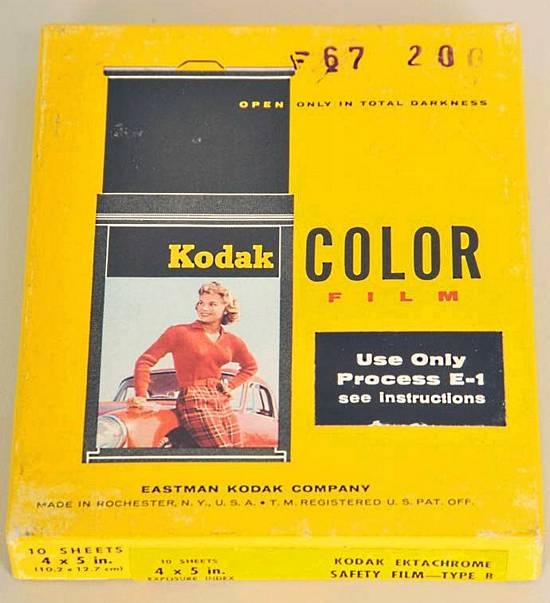
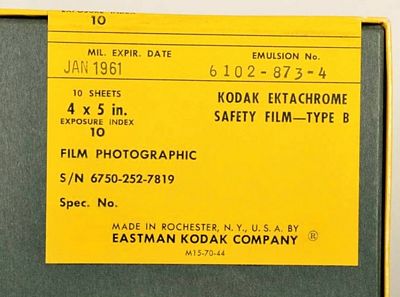
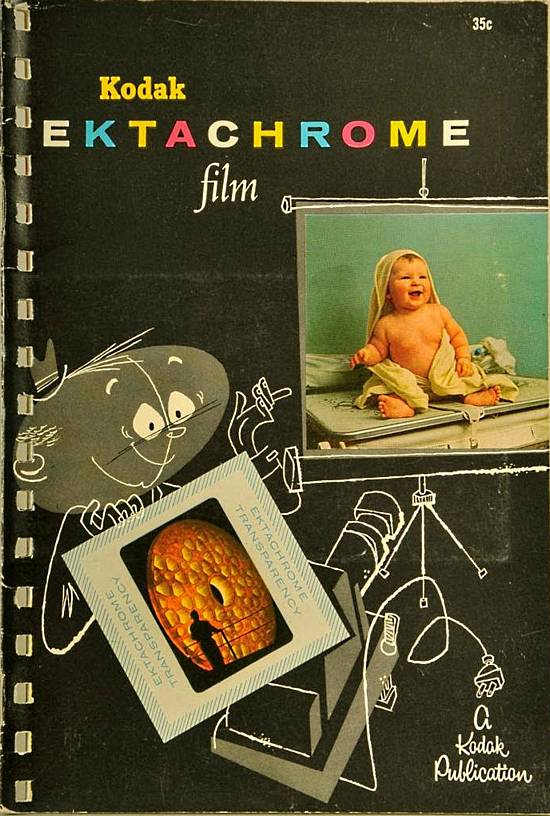 The
helpful book shown alongside is written on the subject of the
new 32ASA Ektachrome films. The book was first published in 1955,
but the one shown has a 1957 printing date. It contains an “Ektachrome
Pocket Exposure Guide” which can be taken out of the book.
The
helpful book shown alongside is written on the subject of the
new 32ASA Ektachrome films. The book was first published in 1955,
but the one shown has a 1957 printing date. It contains an “Ektachrome
Pocket Exposure Guide” which can be taken out of the book.